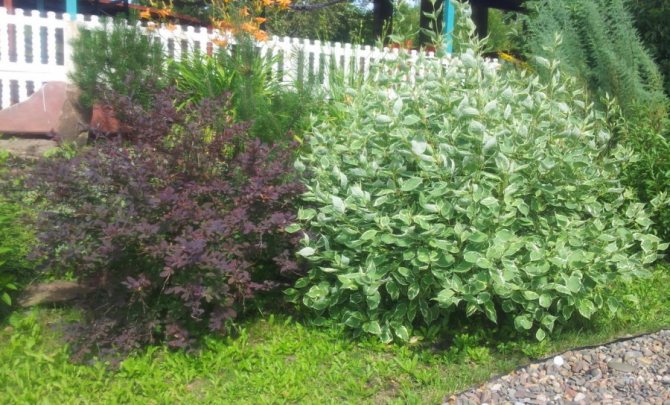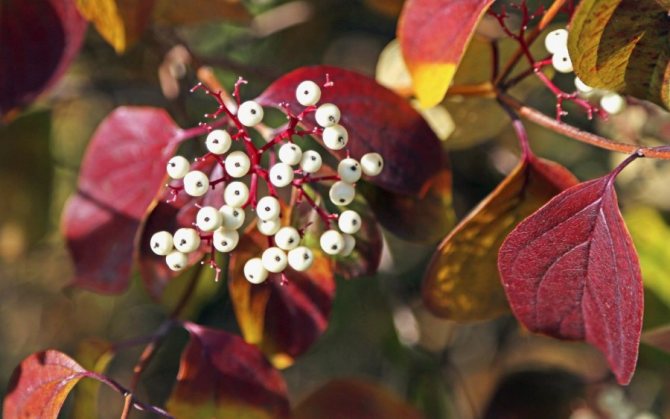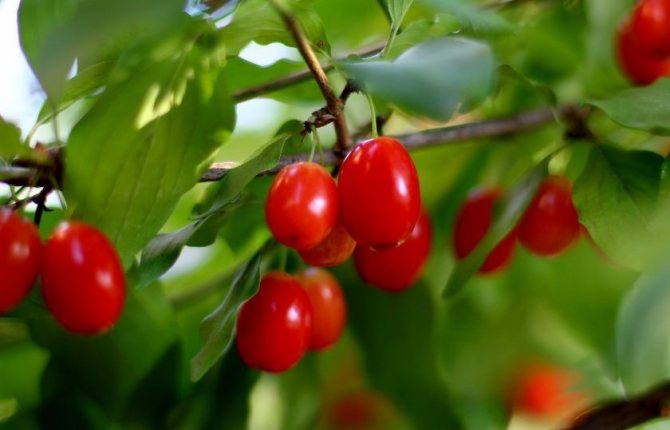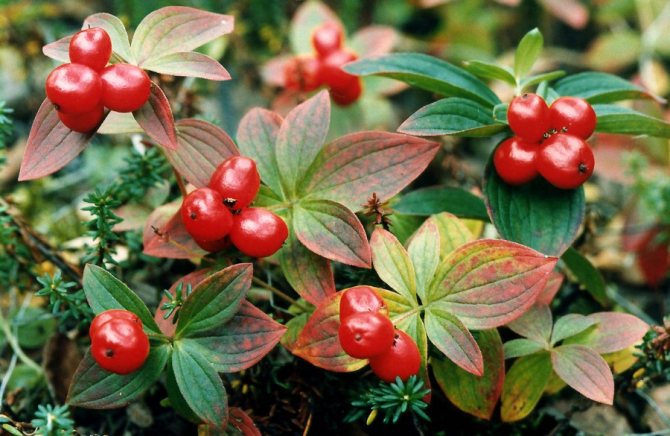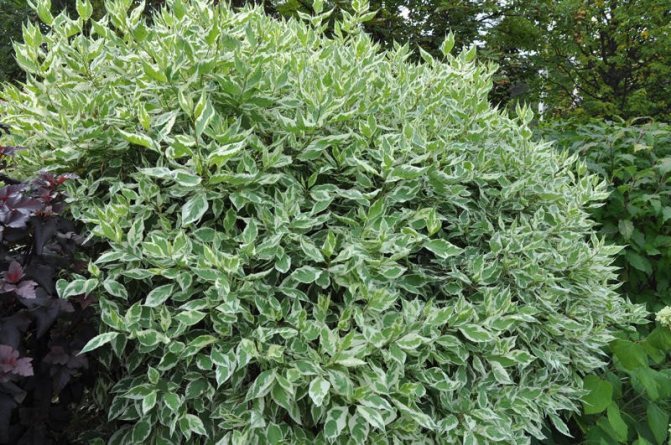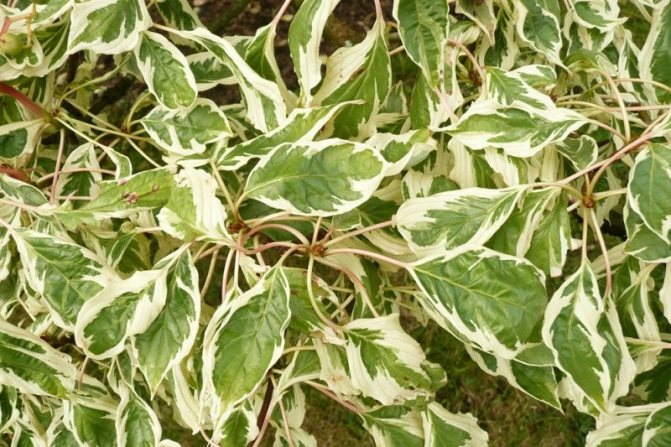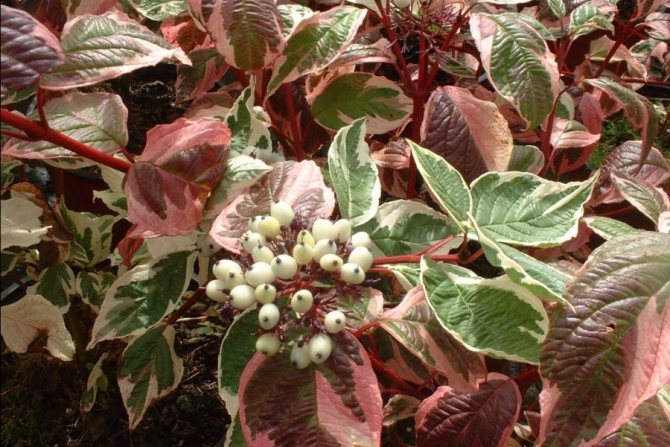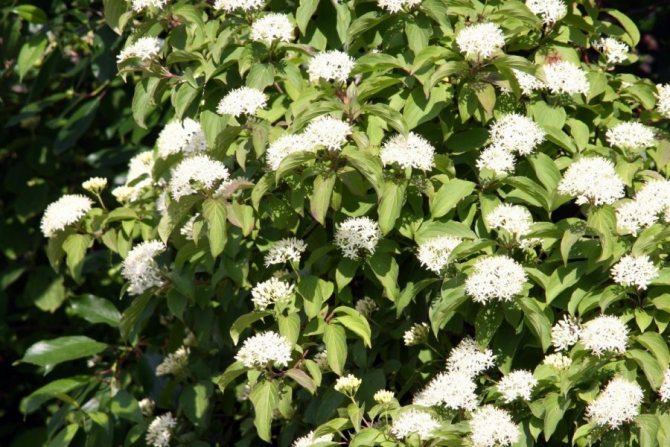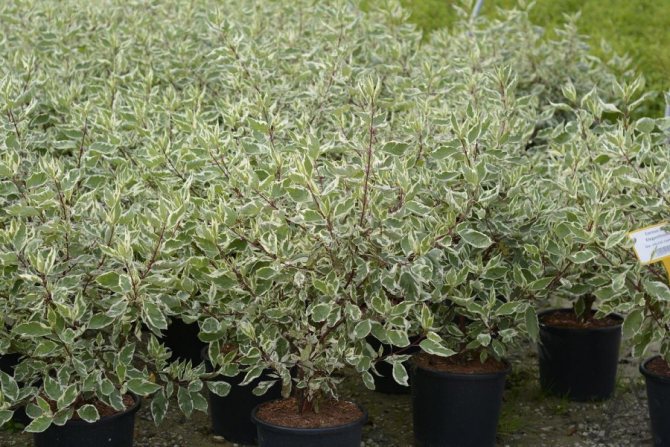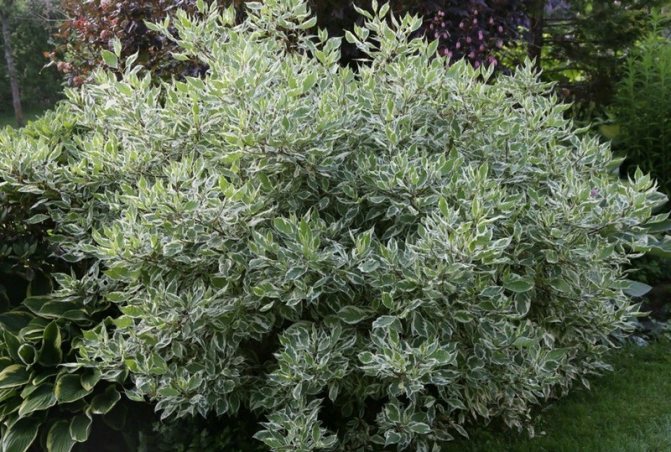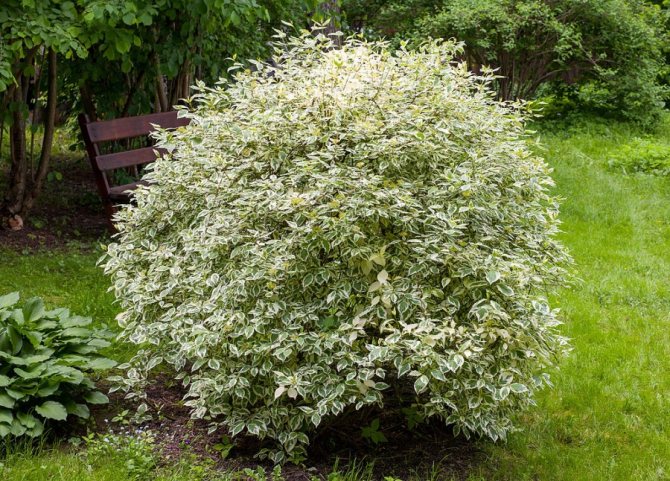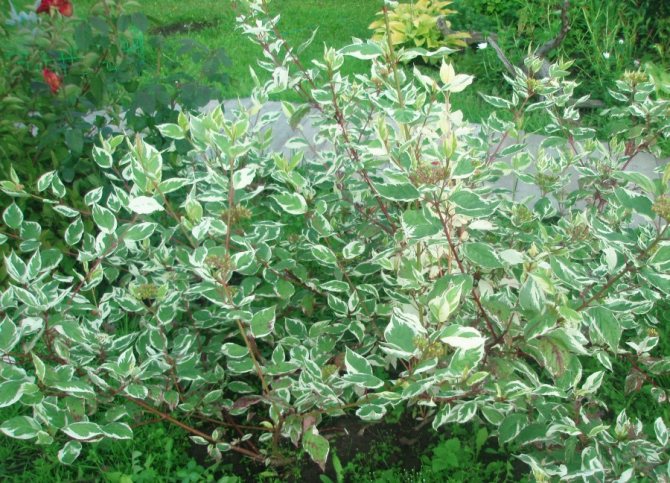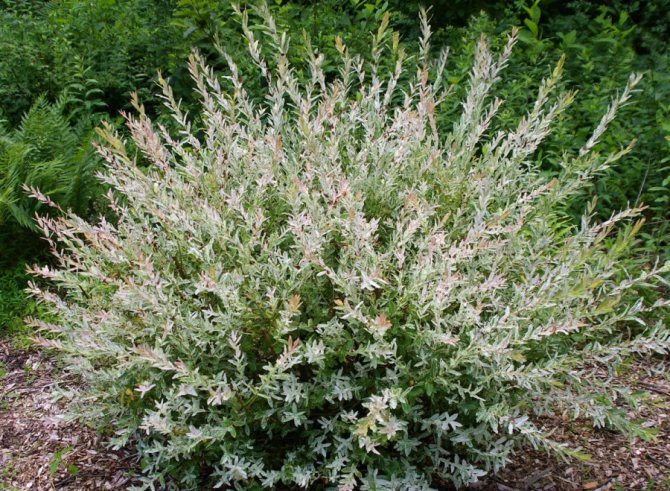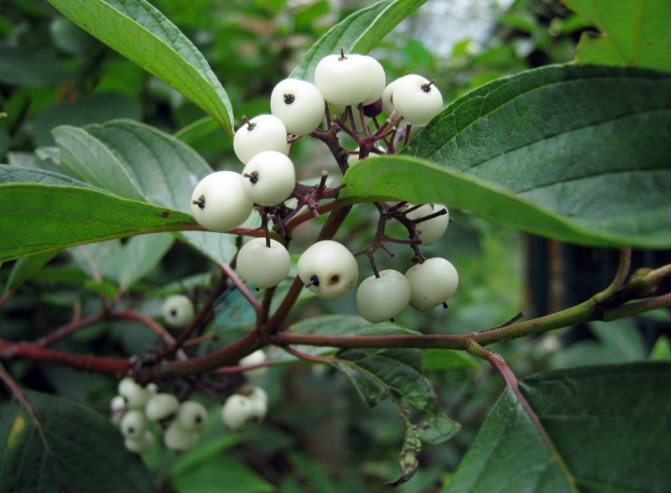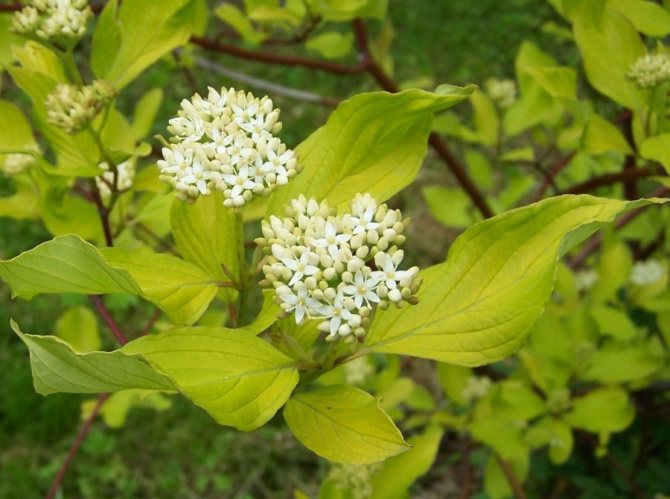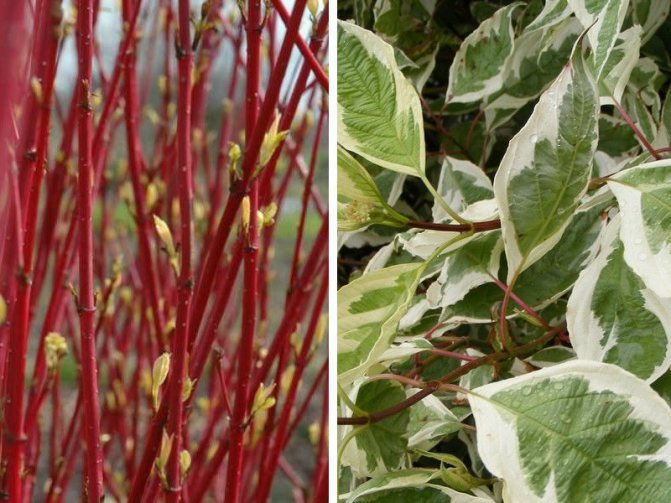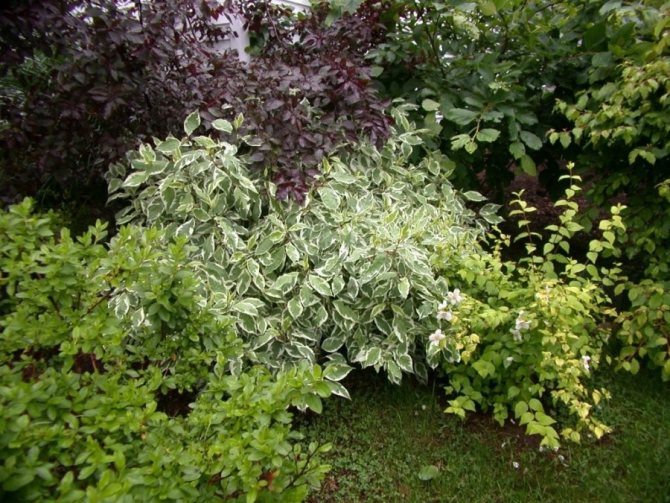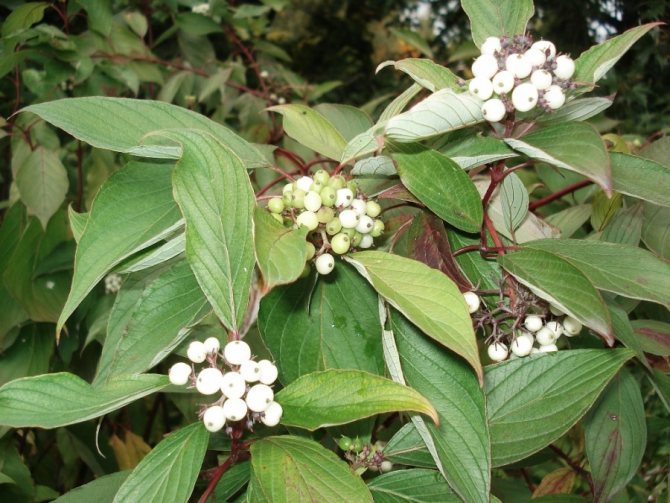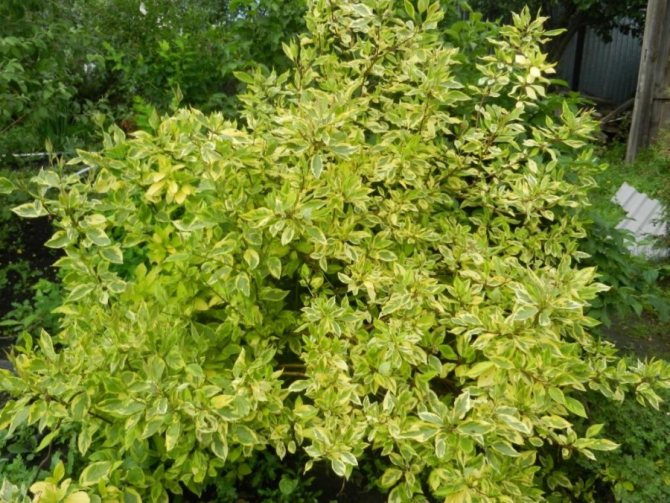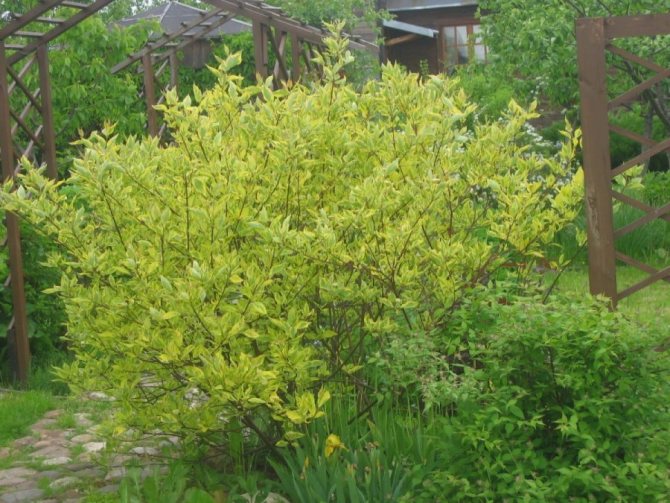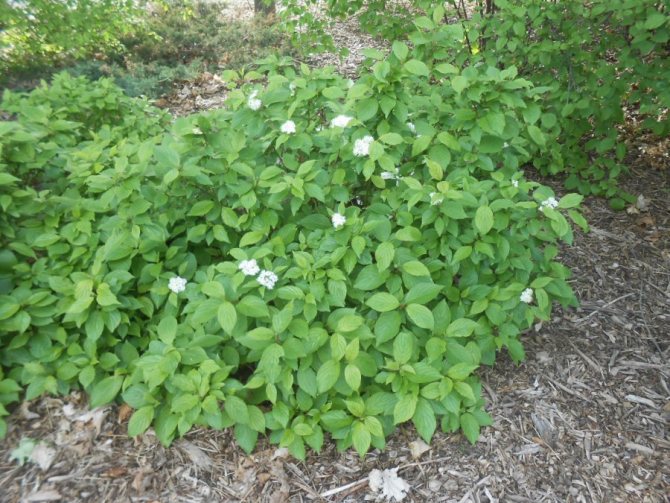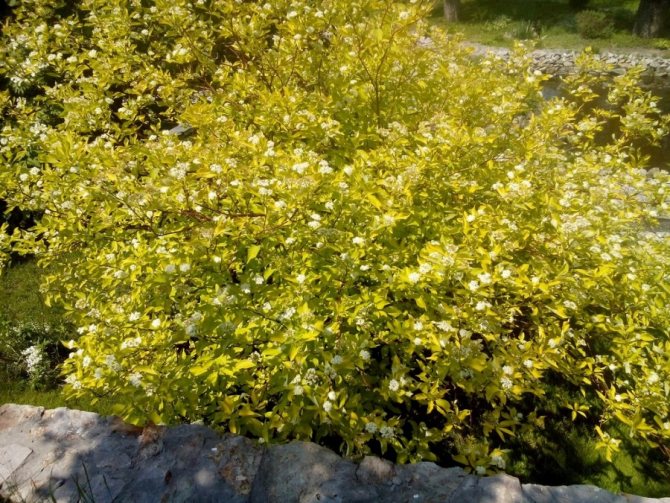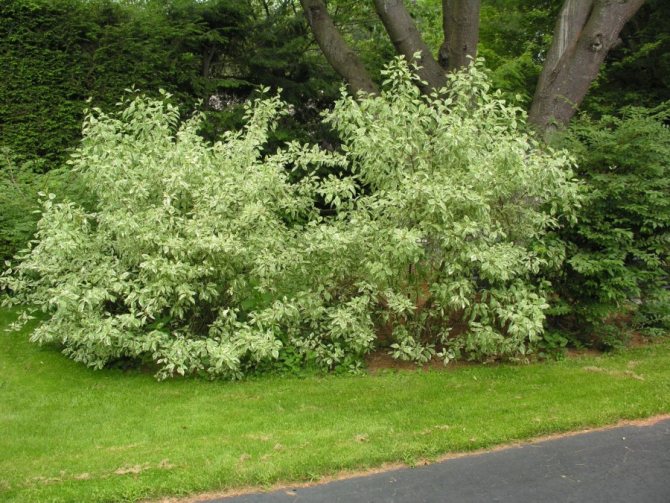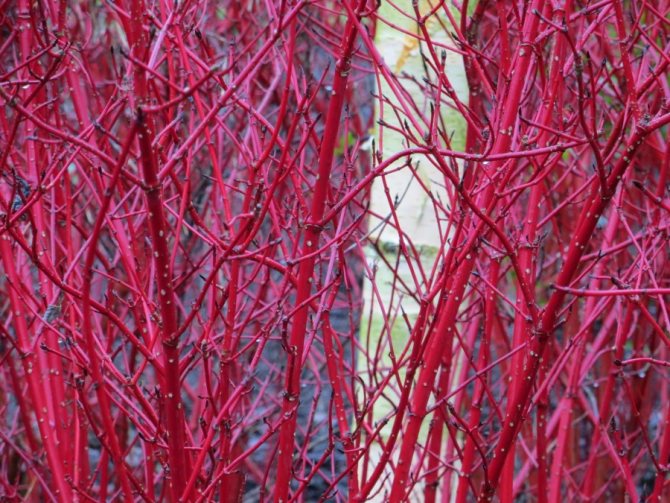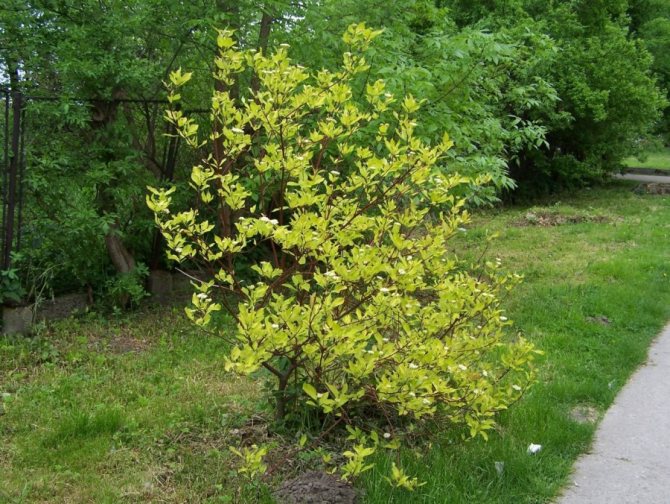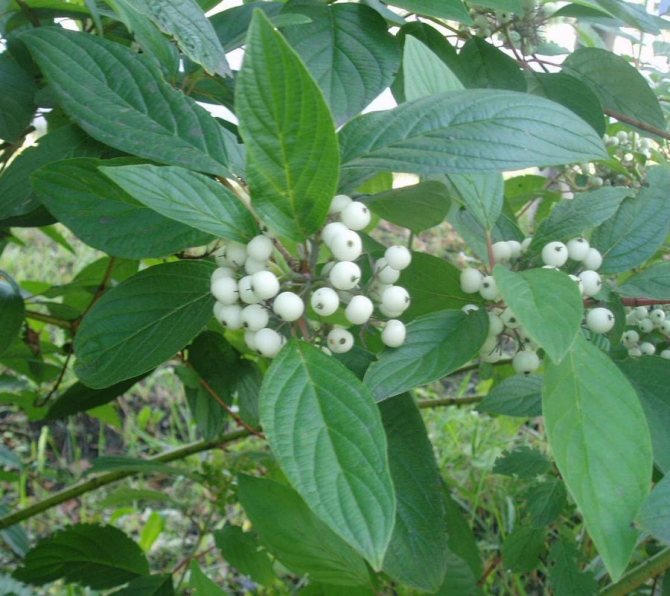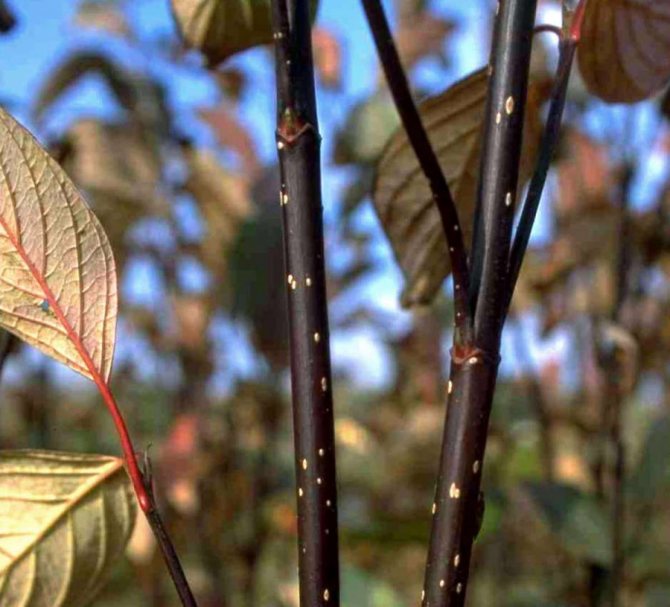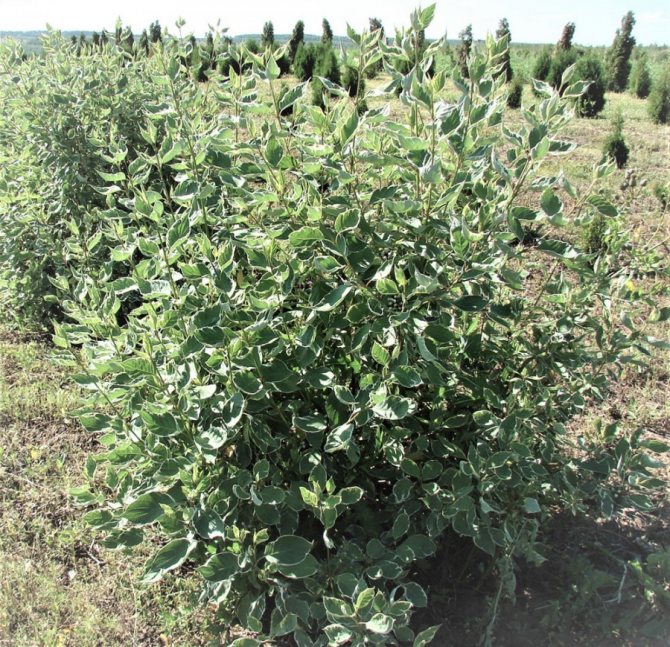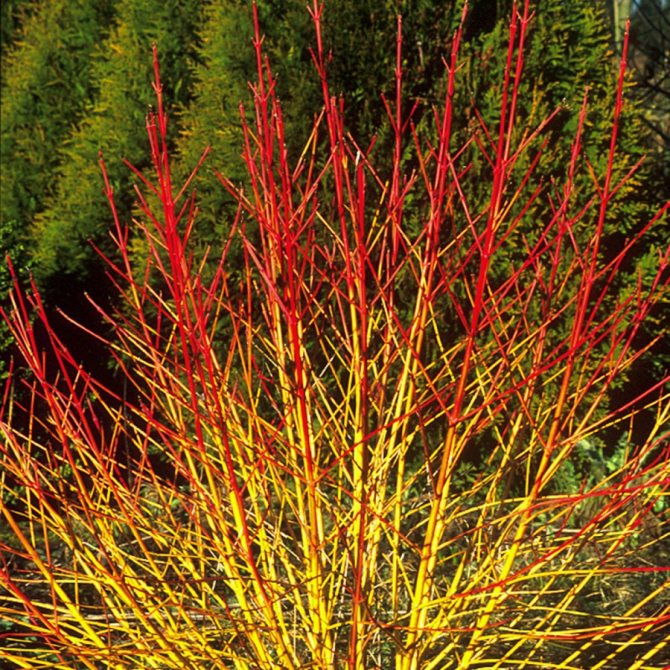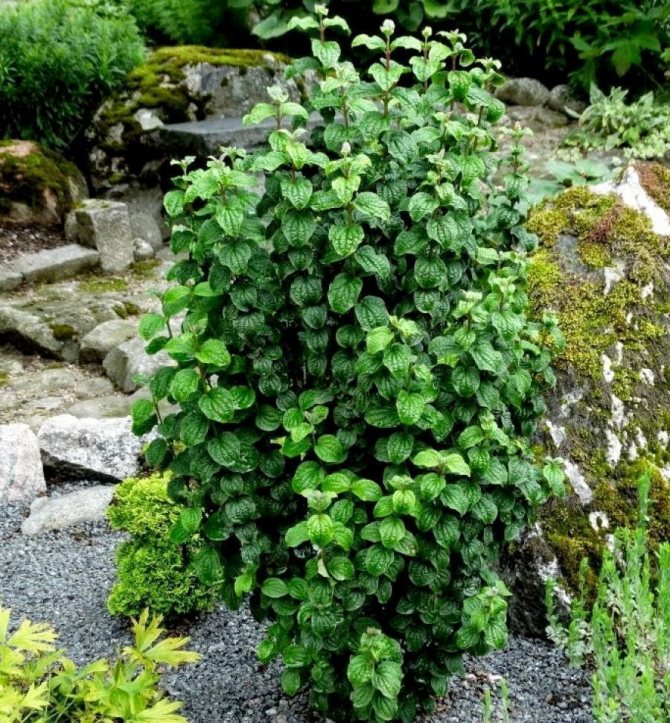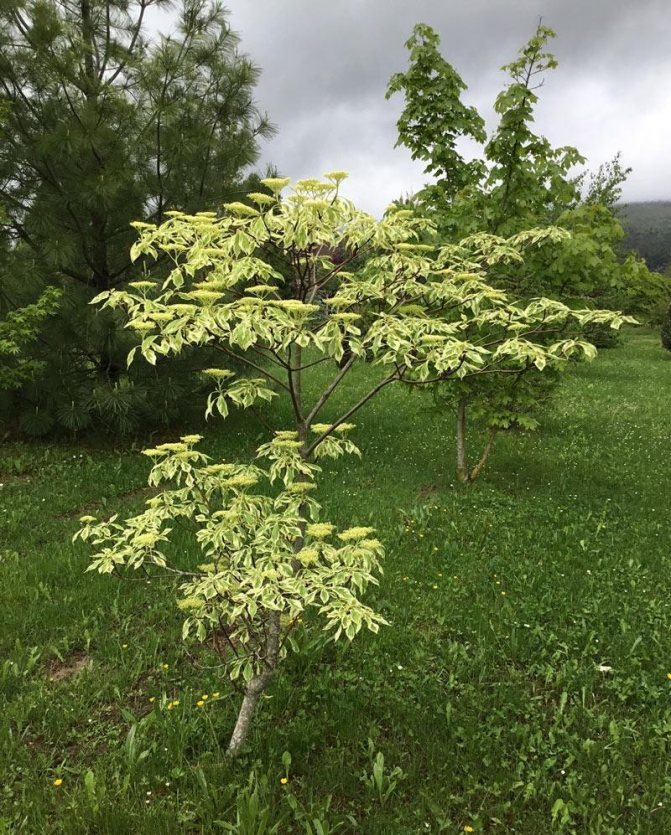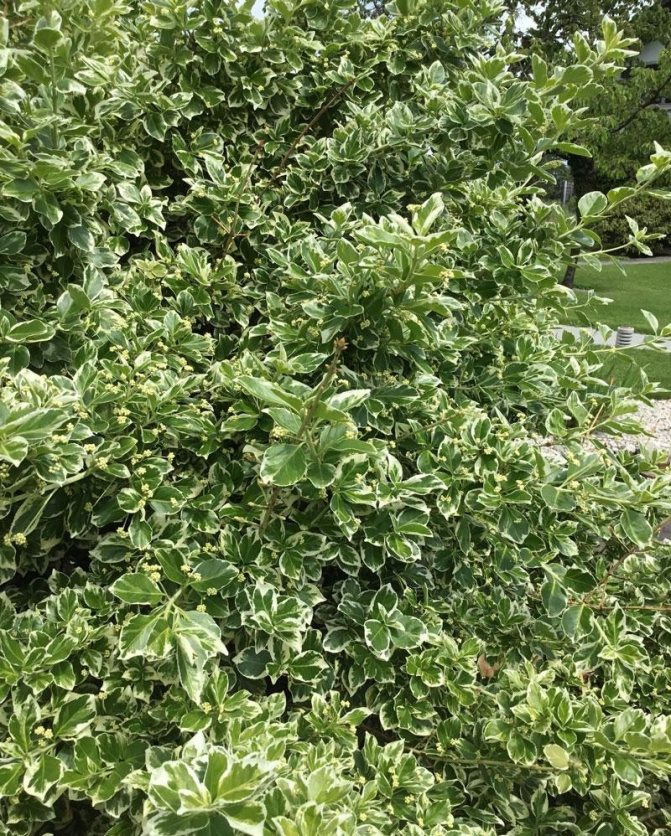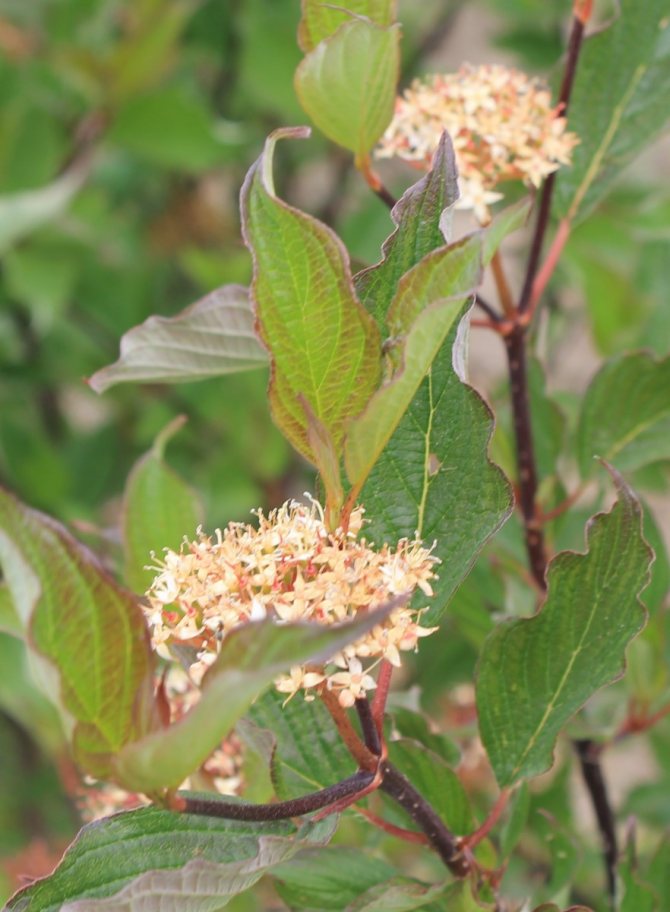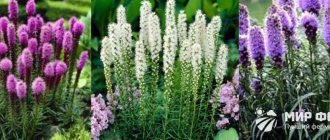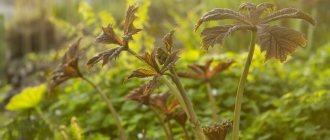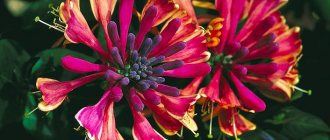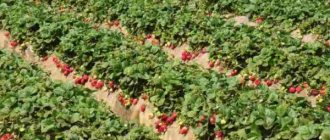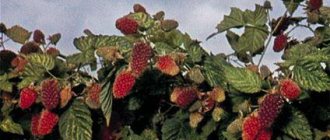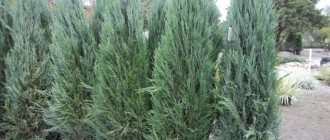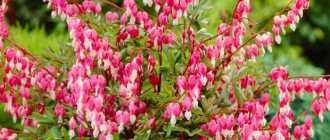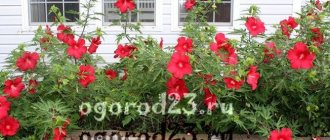Content
- Description
- Types and varieties of deren with photos
- Landing
- Tree care
- Pruning
- Deer cuttings
- Reproduction by layering
- Seed propagation
- Problems in growing turf
- Application in landscape design
Among garden perennials, dogwood represents a special group of shrubs, the decorativeness of which is universal, varietal and species diversity of culture impresses with its beauty all year round - from spring flowering to colorful winter shoots.
The lawn is unpretentious in care, planting is not difficult, and its use in landscape design is very diverse - from hedges to plant compositions of any style.
The genus of deren (Cornus) or dogwood unites about 30-60 species of plants from the Cornaceae family. Most are deciduous trees or shrubs, but some are almost herbaceous perennials.
Description of the plant
Derain variegated is a perennial shrub or small tree that does not exist in the wild. This plant was bred by breeders from the white deer, representing the dogwood family and growing in the Far East, China, Korea and Japan.
Derain is a bush up to 3 m in height and 5 m in width. The bark of its shoots is colored brick or coral, so they stand out especially against the general background even in winter. But the leaves of the plant, which have either a light green or dark green color and a colored border, are of particular decorative value. It can be yellow, cream, lime-colored and almost white.
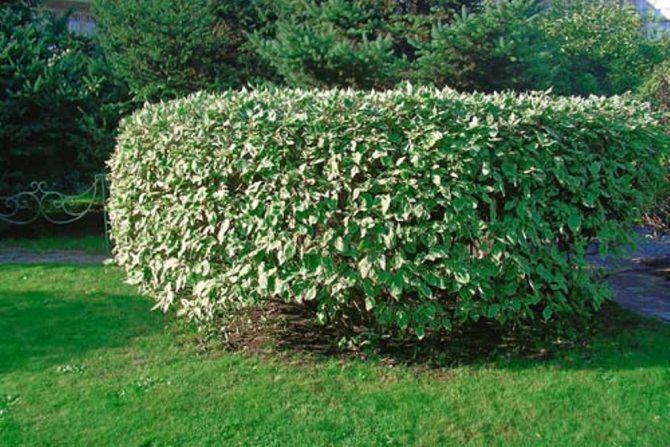
Derain blooms twice a year. The first wave of flowering occurs in late spring and early summer. At this time, many inflorescences are formed on the bush in the form of small shields up to 5 cm in diameter, consisting of small white flowers. In late summer or early autumn, the second wave sets in. Then the foliage takes on a purple or red color with an orange tint, and small greenish-blue berries flaunt against their background. They are very beautiful, but they should not be eaten.
Derain variegated is used to decorate personal plots and park areas. The plant is great for building a single-level or multi-level hedge, as it grows quickly and tolerates pruning painlessly. Often it is included in garden compositions or planted around the site to protect it from drafts.
Varieties and types of deren with photos
White Derain (Cornus alba), also called Alba Derain or Variegated Derain. It has been known in culture since the beginning of the 19th century and is most popular in garden design due to its high decorativeness of varietal forms.
Growing scarlet in the garden
The stems growing from the center are straight and the side shoots can bend towards the ground. This sprawling bush with variegated leaves grows in nature about 3 m in height and stands out with purple-red carmine-pink or purple-burgundy autumn foliage.
It blooms at the turn of May and June with numerous small creamy yellow flowers, collected in flat umbellate inflorescences. Bluish-white spherical fruits ripen in late summer and autumn.
One of the decorative features of the species and all its varietal forms is the intense color of the turf shoots in winter, as if painted with coral-scarlet paint. The smooth bark is covered with a waxy coating, giving the stems a shine.
On shoots over two years old, the red color is no longer so bright, so pruning is necessary every 2-3 years. A new spring growth of a green hue, subsequently turns red at the end of the season. The plant is very resistant to low temperatures and is rarely affected by pests or diseases.
White turf varieties
Derain "Aurea" (Aurea). In addition to the colored shoots, the variety impresses with its golden-yellow spring-summer foliage.
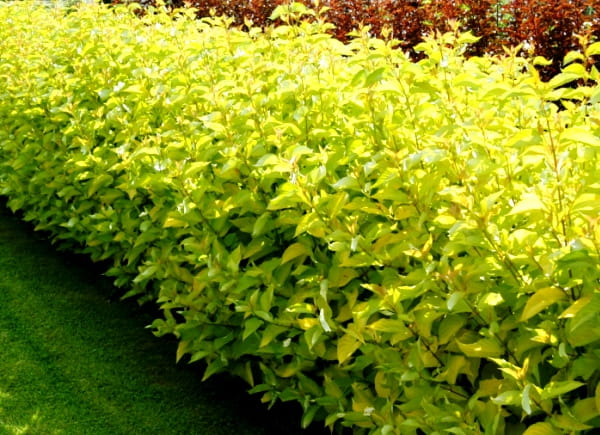

Cornus alba cultivar "Aurea"
Derain "Sibirica" (Sibirica) is known for its bright red stems in winter, which are especially effective on sunny days against the backdrop of snow. Leaves are pale green with white edging. The cultivar has received an award from the British Royal Horticultural Society.
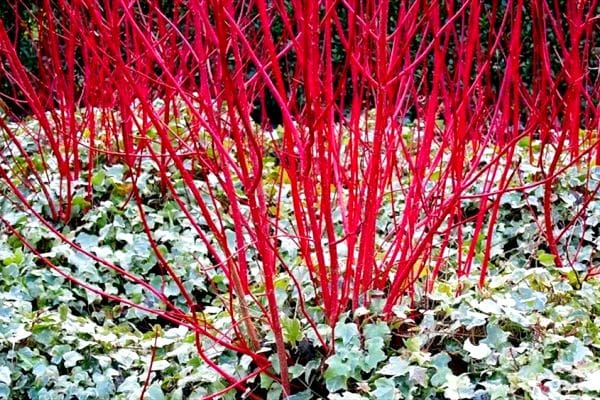

Winter color of the "Sibirika" variety
Sibirica Variegata Derain Beautiful variegated foliage in cream and green tones covers the shrub in spring and summer, making it an interesting addition to garden design. In autumn, it acquires all shades of pink, purple, bronze.
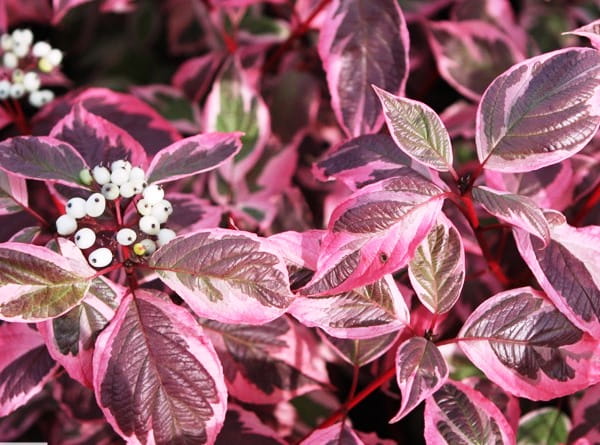

"Sibirica Variegata"
Similar in appearance variegated varieties of white deren "Elegantissima" (Elegantissima) and "Ivory halo" (Ivory Halo or Baihalo) derain with a white irregular rim along the edge of a light green leaf plate and dense red shoots.
From a distance, the bushes look like they are covered with flowers. In autumn, the leaves take on a purple-red hue. Plant height is about 2.5 meters.
"Elegantissima"
Derain "Shpet" (Cornus alba Spaethii). Fast-growing shrub, reaching 1.5 meters in height with straight, usually unbranched shoots.
The outstanding decorative features of this variety are its bright red winter stems and leaves with a bright golden yellow irregular border around the edges with a reddish pink tint at the end of the season. Spaethii is very similar to the Gouchaultii white turf variety, with which it is often confused.
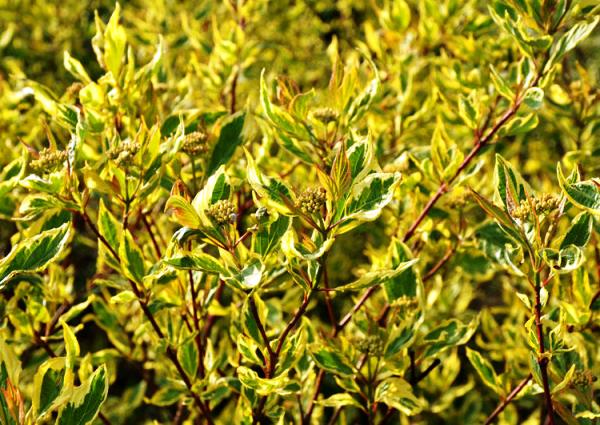

Variety "Shpet"
Derain "Siberian Pearls". Delightful compact cultivar with long, abundant flowering. By autumn, numerous clusters of bluish-white pearl-like berries ripen, which contrast dramatically against the background of purple-burgundy fall foliage and bright red stems.
Siberian Pearls
Another variety of this type of deren is "Kesselringi" (Kesselringii). It is a multi-flowered shrub that forms thickets of dark red stems, which turn purple-chocolate in winter, and brown-red at the base. Seasonal green foliage takes on a purple-red hue with the arrival of autumn.
"Kesselrings"
Derain blood red (Cornus sanguinea) or svidina blood-red. This is a medium-sized bush with a height of about 2 meters. Horticultural varieties are often called "winter fire" as their leaves turn orange-yellow in autumn and then fall off, exposing colorful shoots.
Anny's Winter Orange is one of the best varieties of this kind. In spring and summer, large, green leaves contrast with pale yellow-orange stems.


"Anny's Winter Orange"
In the fall, the bush is strewn with clusters of dark purple berries, the foliage acquires orange-gold and coral shades, and when falling, it opens shoots that turn orange-scarlet with frost. The cultivar is the recipient of the prestigious Garden Merit Award of the Royal Horticultural Society.
Varieties of buddley with a photo
Derain offspring or brilliant dogwood (Cornus stolonifera syn. Cornus sericea)... In the wild, it grows in areas with moist soil in wetlands. Height 1.5-4 meters. It spreads easily by underground lateral rhizomes that give rise to new growth. The branches are dark red in the sun and brownish green when planted in the shade.
Flaviramea yellow turf is a well-known variety of this species. It is a compact, low bush, the decorative feature of which is bright yellow winter shoots.


Flaviramea
Canadian Derain (Cornus cyananthus) refers to miniature, ground cover species with a height of only 20 cm. Growing up, it forms green carpets, strewn with cream or white flowers in spring, and red edible berries in autumn.
For successful cultivation, it needs partial shade and moderately moist soil with a slightly acidic reaction. It is a frost-resistant species that can withstand temperatures as low as -40 ° C, and is resistant to pests and diseases.
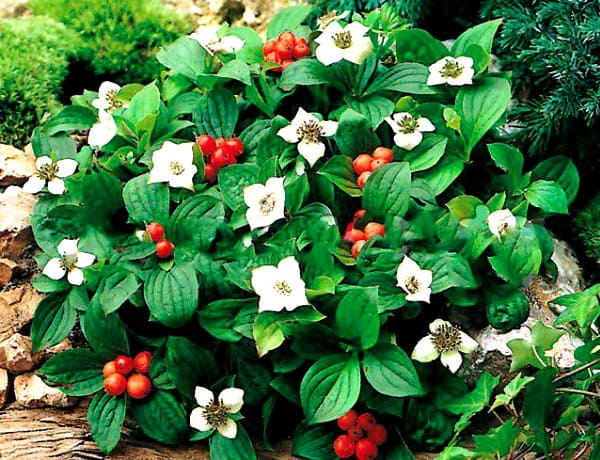

Cornus cyananthus
Deren Kousa (C. Kousa) or Chinese. The species belongs to the group of flowering dogwoods. Its peak bloom is in June and is striking in its splendor. The tree is covered with large flowers of pink, white or red-pink color, depending on the variety. Delicious red fruits are tied after flowering.
"Miss Satomi"
Pink flowering varieties: "Miss Satomi", "Scarlet Fire". White and creamy white flowers: "China girl", "Milky way", "Venus", variegated varieties with different colors of flowers "Akatsuki", "Summer Fun", "Wolf's Eyes".
Types, varieties
The following varieties of variegated sod are most popular:
- Elegantissima... The shrub is distinguished by a special rich color of the bark of the shoots - it is dark purple and leaves of a concave shape look very impressive against its background. They are painted gray and have a white border.
- Various Siberian... The color of the bark is less intense. It is colored green with a red tint. The green, flat leaves have a white border.
- Gusholti... Derain of this variety forms a very massive bush, covered with relatively small green leaves with a wide yellow border.
- Cream cracker... This is the only shrub whose crown rises upward. It has very delicate light green leaves with a thin creamy border.
Below are photos of variegated deer varieties in the same order in which they are described.
Possible growing problems
Variegated dogwood is an extremely problem-free plant. To ruin it, you need to try very hard. It practically does not suffer from pathogenic fungi. The only exception is root rot, the development of which is most often provoked by the gardener himself, too often and / or watering the plantings abundantly. Pests on the shrub also do not pay special attention. Only aphids can cause significant harm to him.
Another possible problem is that the leaves lose their tone, numb. This is due to a shortage of moisture in the soil and most often occurs during prolonged heat and drought. It is enough to water the plant abundantly several times, and its condition will return to normal.
Aphids effectively repel any infusions with a pungent odor. It is enough to process the bushes twice a month. As raw materials, you can use any spicy herbs, wormwood, yarrow, tomato and potato tops, marigolds, onion and garlic arrows.
Aphids are an extremely omnivorous garden pest that feeds on plant sap
If pests are found, the turf bush is sprayed with soapy foam, after about half an hour it is washed off with water from a hose. If the desired effect is absent, the same infusions are used, but the interval between treatments is reduced to 6–8 hours. Other effective means are baking soda or soda ash diluted with water, mustard powder. In the event of a mass invasion of a pest, any general-purpose insecticides are used.
Root rot is dangerous because the pathogenic fungus develops for a long time without manifesting itself in any way. When the first symptoms are noticeable on the aerial part of the bush, it is usually too late to save the plant. The bases of the shoots soften, turn black, become slimy to the touch, and can become covered with a layer of mold. They give off an unpleasant putrid smell. The leaves lose their tone, sag, dark spots blur on them.
Symptoms characteristic of root rot appear only when the development of the disease has gone far
To prevent the development of rot, potassium permanganate is periodically added to the water for irrigation to a pale pink color.Crushed chalk or wood ash is poured to the roots. Having found characteristic signs, watering is reduced to the required minimum, all affected shoots are cut off. Trichodermin and Glyokladin granules are added to the soil. The plant itself is sprayed 3-4 times with a solution of any fungicide. But these measures may not work. Then the turf bush can only be dug up and burned. For disinfection, the soil in this place is spilled with a 5% solution of potassium permanganate or Bordeaux liquid. Layers and cuttings can be taken from the affected plant, but only from healthy shoots.
Choice of place and conditions of detention
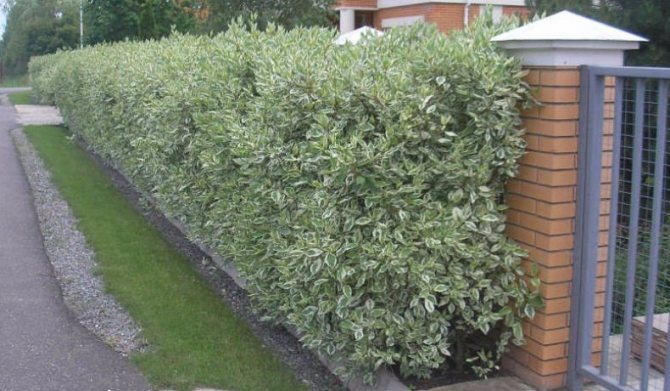

Let us find out under what conditions the turf must be kept so that its foliage does not fade and retain its decorative qualities.
Lighting and location
Derain variegated loves the sun and prefers to grow in well-lit areas. However, it can be placed in partial shade, and the plant will not suffer from this. But you should not plant a shrub in the shade: from a lack of sunlight, it will grow frail, rare and unattractive.
Temperature
The optimum temperature for sod is + 15 ... + 20 o C. With good irrigation of the soil, the shrub tolerates the summer heat well. Adult plants hibernate without shelter, withstanding frosts down to -40 o C. Only young bushes need to be sheltered.
Air and humidity
The shrub prefers moderate humidity and does not tolerate dry air in hot summers. Therefore, in the heat, you should take care of abundant watering. The plant is not afraid of drafts, but it protects other inhabitants of the garden well from them.
Priming
Variegated turf is undemanding to the composition of the soil. However, it grows best on loose and nutritious soils with a neutral reaction. They should not contain a lot of sand, as it does not retain moisture at the roots. With a close occurrence of groundwater, the shrub needs good drainage.
Landscaping ideas have no boundaries
Many professionals and amateur gardeners use wood in the design of plots. They embody ideas in design:
- alpine slides and garden ponds;
- border edging of park alleys;
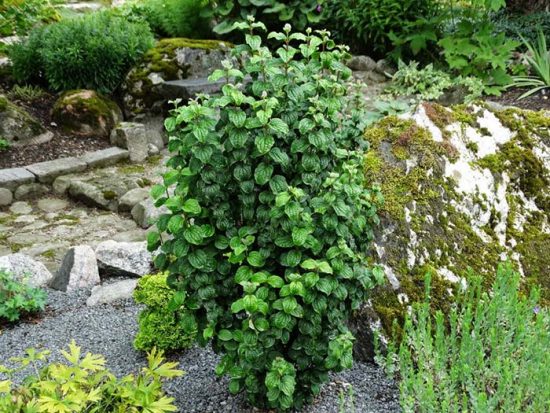

- hedges for personal plots;
- green or purple sculptures in "English" gardens.
Some people come up with new forms for deren. Elena (29 years old, Moscow) writes: “Last year I made Japanese bonsai from deer in the garden, it turned out very well, it is not difficult to cut it, the shape is stable”. You should like the idea of another amateur gardener: Gleb (46 years old, Ryazan) - “When planting deren in a hedge, I alternated red deren with other species. I pruned it every year in the spring, but this year I did not. In the fall, the red branches rose in height and became like flaming torches. All winter we admired these bonfires, beautifully. "
From everything that we have told you about the decorative tree, we can conclude: the plant is unpretentious, very resistant to our climate, does not require special care, harmful insects and diseases bypass it, but you should not completely forget about it. The plant will surely thank you with its lush greenery, will delight you for many years, decorating your gardens with its healthy look.
When to plant
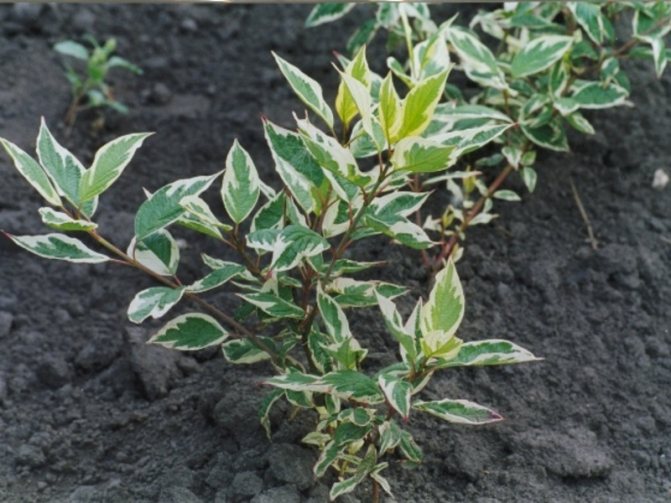

The best time to plant variegated turf is spring. Saplings tolerate frost easily. Therefore, they can be planted in open ground in early June (in the Moscow region and central Russia), when the ground is already warmed up enough, but from time to time it still continues to freeze at night. In the southern regions of the country, the dates are shifted 2-3 weeks earlier (to April), since spring comes earlier there. And in Siberia and the Urals - 2-3 weeks later (at the end of May or the beginning of June).
Preparing for landing
The procedure for preparing a seedling for planting:
- Examine the root system and cut off damaged and diseased roots.
- Soak the roots for 2 hours in 0.2% Fundazole solution or lilac solution of potassium permanganate.
- Then soak the roots of the deren in water with the addition of Zircon or Kornevin. These preparations will accelerate the adaptation of the plant to new conditions.
Attention! It is best to plant young bushes up to 4 years old in the ground. They tolerate landing better and take root faster.
Planting process
Planting deren in the ground step by step:
- Prepare a planting hole up to 50 cm deep and in diameter.
- If the groundwater is close to the bottom, lay a layer of crushed stone or crushed brick, and then cover it with sand.
- Partially fill the pit with nutrient mixture (compost, humus, leafy soil).
- Place the seedling in the hole and spread its roots.
- Fill the gaps between the roots and the hole to the end.
- Compact the soil and make a roller around.
- Pour a bucket of water under the bush and sprinkle the hole with dry earth so that a crust does not form.
Advice! If the soil is acidic, add 0.5 kg of wood ash or 200 g of dolomite flour to the nutrient mixture to fill the pit. Lime can be used.
Seed propagation of deren
Seeds of hybrid and varietal forms are often sterile, but viable material is commercially available. Seeds require a long period of stratification to germinate. Sown outdoors in October, they germinate in spring in March or April. Although some seeds can only germinate after a year.
Young shoots are weak and need protection from sun and wind for several months. Therefore, the seed is best sown in containers, where they can be germinated indoors. The stratification period takes approximately 4 months.
The seeds are placed in a bag in wet sand and stored in a refrigerator at a temperature of 2-3 ° C. After a period of stratification, they are sown in a wet mixture of sand and peat, germinated at a temperature of 18-20 ̊С.
Planting bulbous flowers in autumn
With the appearance of 3-4 leaves, the seedlings dive and are planted in separate pots in fertile soil. Planting deren in open ground is carried out after 2 years of cultivation in a pot.
Problems in growing turf
1. The most common fungal disease of ornamental turf is anthracnose. The disease begins with the appearance on the leaves of brown spots with purple edges, which subsequently turn brown, and the leaves curl and dry out.
Secondary signs of the disease are necrotic brown areas on the bark of branches and trunk. Treatment is effective if the disease is detected before the branches begin to die off.
Symptoms of anthracnose in white variegated turf
2. In thickened plantings with high humidity and poor air circulation, plantings can be affected by powdery mildew, most often at the end of summer.
Its symptom is a white-gray powdery coating on the leaves, which eventually discolor and curl. Warm, dry days and cool, humid nights contribute to the development of the disease.
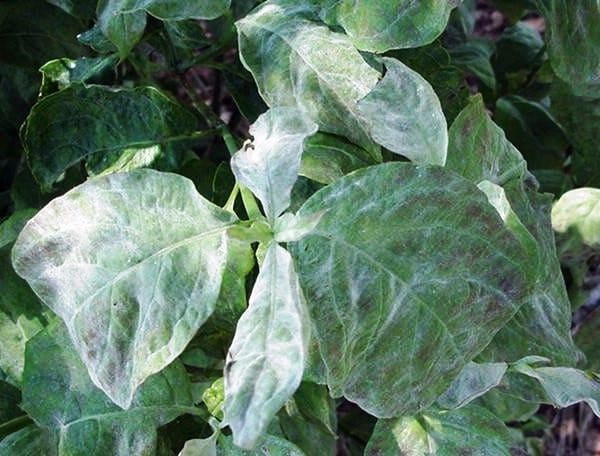

Powdery mildew
3. The leaf spot is caused by the fungi Cercospora cornicola and Septoria. The disease is most common during the humid summer months and can affect all foliage that falls off prematurely. Usually, the disease does not greatly affect the growth and overall health of the bush, but repeated years of early abscission can weaken the plant.
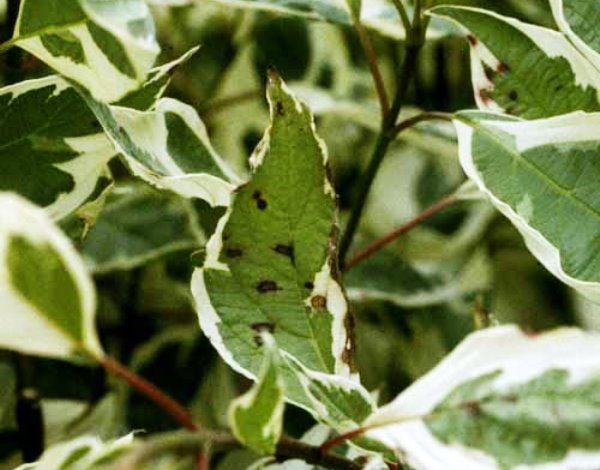

Leaf spot
The control of all fungal diseases consists in proper care of the lawn, timely removal and burning of the affected plant parts, improvement of air circulation, and the treatment of plantations is carried out with the help of repeated treatments with fungicides.
4. Darkening of the tips and edges of the leaves, wilting, curling, the appearance of a pinkish tint on the back of the leaf plate are the result of stress caused by drought, heat stress or prolonged flooding of the soil. Symptoms like these can also be a sign of over-feeding.
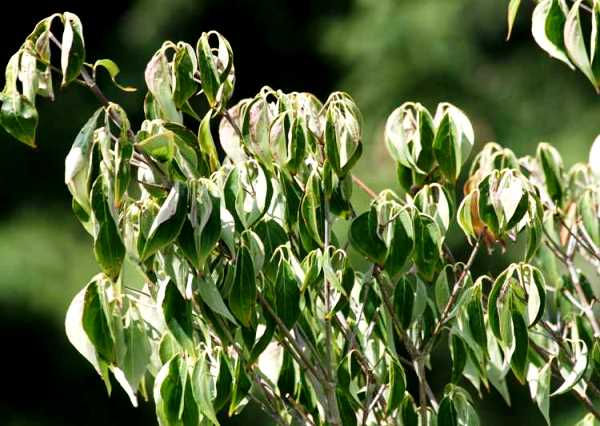

Leaf withering due to heat and water stress
5. Leaves burn.It looks like a disease, but the reason lies in too dry environmental conditions, which cause severe stress on trees and shrubs of turf.
Foliage burn
The leaves at the edges dry out and turn yellow. Due to their shallow root system, young seedlings susceptible to drought are most susceptible to burns.
Rules for care and cultivation in the garden
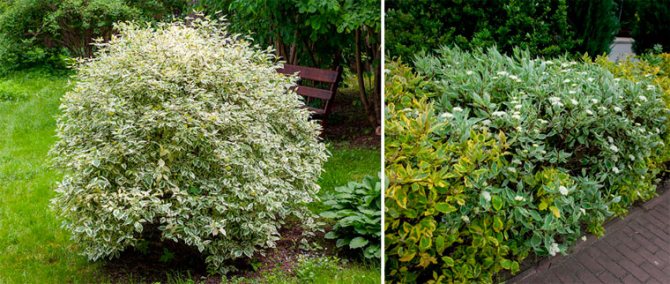

Caring for variegated turf is simple, but you should still know some of the nuances.
Watering
Watering young plants should be 2-3 times a week with water settled outside. The earth must not be allowed to dry out completely. Adult bushes are able to independently produce water in the required amount. Therefore, they should be watered only during drought periods. Then 10-20 liters of water is poured under each bush twice a week. A deren that needs watering has no foliage.
Top dressing
The variegated dogwood should be fed twice a year: before the first and before the second wave of flowering. For this, it is best to use complex mineral fertilizers for ornamental shrubs. Up to 200 g of fertilizer can go under an adult bush at a time. In the spring, plants respond well to the introduction of organic matter. To do this, under each bush, it is enough to add 1 bucket of humus or fatty compost.
Loosening, mulching
Loosening is required as the topsoil hardens. The plant responds well to mulching. For this you can use peat, sawdust and stones.
Pinching, pinching, pruning
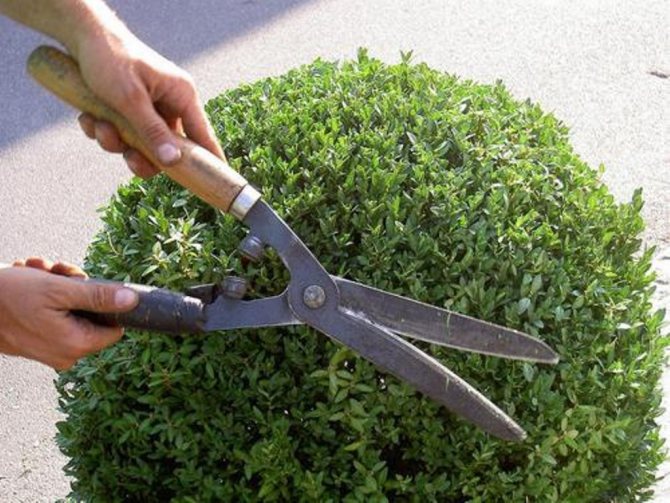

The shrub needs annual sanitary and formative pruning. It is often held twice a year: in early spring and late autumn. During pruning, dry, fatty, damaged and diseased shoots are removed. Additionally, the bush is given any shape: a rectangle, a ball, a pyramid or another. Derain will quickly release new shoots and young leaves, and from this it will look very well-groomed and elegant.
Transfer
Variegated turf does not need replanting. It can grow in the same place for as long as you like. He will need it only when the wrong place was initially selected for him. For example, water is close to the site, or a shadow falls on it all day.
Reproduction by layering and root suckers
This propagation method is more effective than using cuttings. The lateral thin shoot is tilted to the ground in a pre-prepared shallow trench, cut from below, and the cut site is treated with root hormone. Then fasten with wire and sprinkle with earth mixed with compost, leaving the end of the stem above ground level.
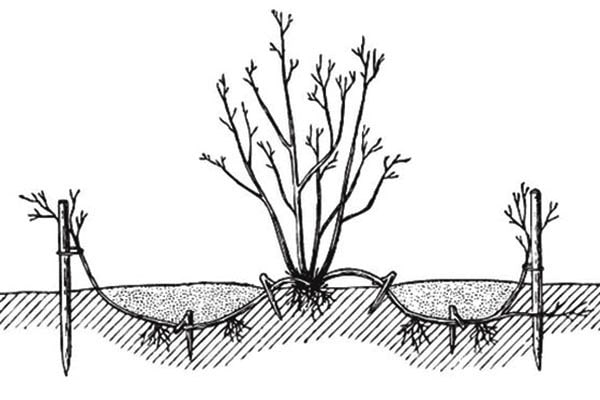

Reproduction by layering
This technique works best in early spring or late summer. The soil around the buried branch should remain moist until roots emerge, a process that can take several months. The rooted area is cut off from the main plant in early autumn or next spring and planted in a new place.
Root offshoots of the bush, after cutting off with a part of the root and a lump of earth, are ready for planting. The procedure is carried out in spring or autumn.
Growing features
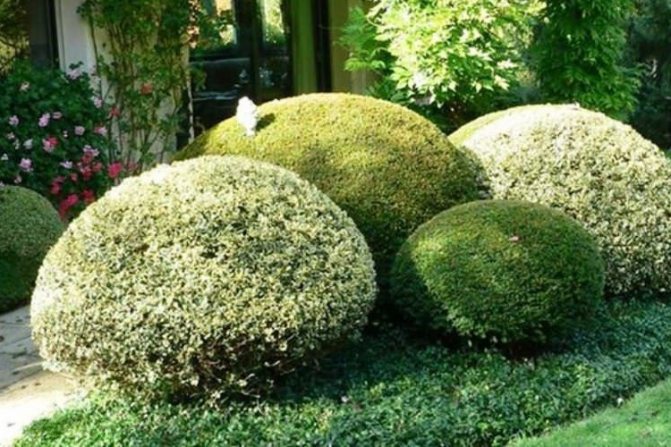

The leaves of the variegated turf have an unpleasant taste, and therefore pests bypass them. The only insect that can harm shrubs is aphids. A soap solution can be used to destroy it. But if the invasion of aphids is grandiose, then you cannot do without the use of poisons. Help against aphids: Aktara, Inta-vir, Karbofos and other insecticides.
But the lawn is susceptible to fungal diseases. They develop as a result of stagnation of water in the ground during the rainy season and with improper watering. To cure a shrub, it must be treated with a 0.2% Fundazole solution. In a rainy season, it should be sprayed for prophylactic purposes with the same drug once every 2 weeks.
Variegated turf is a very beautiful shrub that is an excellent decoration for gardens and parks.He requires special treatment only at a young age, then caring for him is reduced to a minimum: it will even need to be watered only during a drought period. And if you connect your imagination and master the skills of formative pruning, you can grow a real green sculpture on your site.
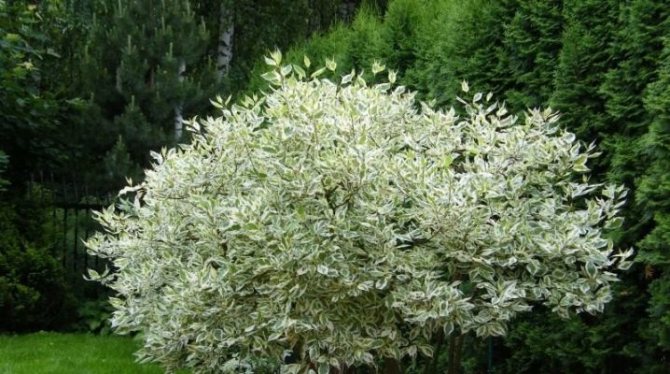

Derain variegated is an ornamental plant that is rapidly gaining popularity among the owners of private houses and cottages. It looks very impressive, so the culture is often used in landscape design, and the shrub is attractive both in summer and winter, and besides that, it is unpretentious and resistant to the most difficult climatic conditions.
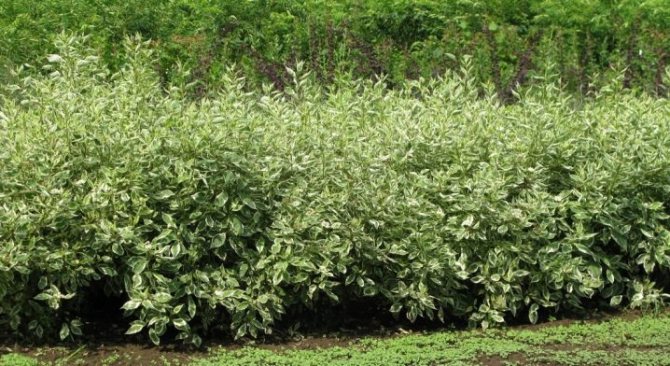

Decorative turf - care after planting
After planting, the sowing seedlings are very sensitive to drought, therefore, watering is carried out in the absence of rain every 2 days for a month, and then during the next year they are watered abundantly once every 1 week, maintaining an average soil moisture. In the summer heat, watering is increased.
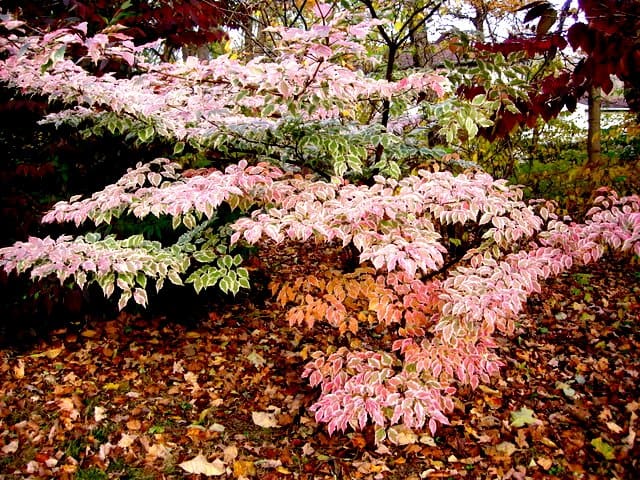

Variegated dogwood in autumn, variety "Wolf's Eyes"
Adult 4-5 year old plantations can withstand a short-term drought, but in conditions of a prolonged lack of water, the foliage withers and dries up. After abundant irrigation (2-4 buckets per bush), the elasticity of the leaves is restored. Irrigation in summer is best done in the evening, pouring water into the near-stem hole.
Attention! Good growth and decorativeness of the culture are possible only with constant substrate moisture
To prevent the evaporation of water from the soil, to protect it from overheating in summer and cold in winter, mulching the soil around plantings, especially young ones, will help. Mulch from compost or peat is poured in the near-trunk circle, without touching the base of the shoots or the trunk.
Some varieties can freeze slightly in cold winters, but Coase's grass is especially sensitive to cold. Young plants of this species need shelter from non-woven material, and protection roots from a high layer of mulch from spruce branches or fallen leaves.
Seasonal feeding is part of the maintenance of the lawn in the garden. For good growth and flowering, they are fed with balanced slow-acting mineral fertilizers in the form of powder or granules.
Fertilized during the active growing season of shoots in May-June. In autumn, potash dressings are relevant, which increase the plant's resistance to low winter temperatures and diseases.
Description of the variety
The variegated dogwood is one of the brightest achievements of breeders; this plant does not grow in its natural environment. The species was obtained on the basis of a white deren from the cornel family. Such a plant has green monochromatic leaves, but through the efforts of scientists, several bright colors were added to them, as a result, a border of yellow, pink, golden and white-beige color appeared on the foliage. The shape of the leaves is heart-shaped, the edge is even, the main vein is clearly pronounced.
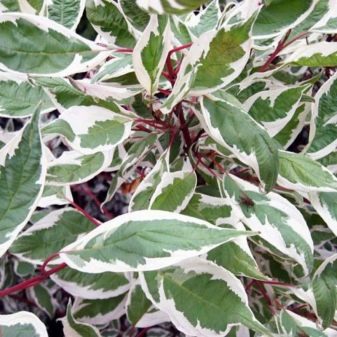

Derain variegated is a shrub or small tree, grows up to 2.5-3 meters in height, while the crown reaches 4-5 meters in diameter.
The bark has a rather unusual color - coral or saturated brick, which gives a glossy shine in the sun. That is why the plant is so popular with landscape designers. It does not lose its decorative and exotic character even in the winter months, having lost all its foliage. At this time, its red branches look especially beautiful against the background of sparkling white snow.
The culture bears fruit twice a year. The first time it blooms at the end of May - the first half of June, and the berries appear after 1.5 months. The second wave occurs approximately in the last decade of August - early September, respectively, the plant gives the second harvest of ripe berries already in October. They look extremely stylish against the background of yellowing and purple foliage. The flowers of the tree with thyroid inflorescences are 4-5 cm in size, the fruits are blue and bluish, but for all their attractiveness they are completely inedible.


A distinctive feature of deren is the increased growth rateas well as the ability to tolerate any trim, even radial, without any damage. Moreover, the more often such procedures are carried out, the thicker the crown becomes. It is this feature that is used when arranging hedges. It should be noted that pruning is the main part of the care of the turf, since the branches that grow uncontrollably look extremely untidy and unattractive.
The plant is absolutely undemanding to care, the culture can adapt to almost any habitat, the turf is unpretentious neither to the composition nor to the structure of the soil, it can withstand even the most severe Siberian frosts and grows easily in the southern regions. There are several varieties of deren, so every gardener will always find one that suits his taste. They all differ in their appearance, but at the same time each one looks invariably impressive.
- Elegantissima. It is one of the most common varieties of deren and is often planted in single plantings. The shrub reaches a height of 2.5 m, shoots are rich coral, straight, young foliage is green with a slight bluish tint, the border is milky white, the leaves are pointed and slightly concave inward.
- Sibirica Variegata. This is a low-growing shrub that grows up to 1.5 m. Shoots are bright scarlet, almost bloody. The leaves are elongated, light green with a creamy edging. With the onset of autumn, they change their shade to bright purple with a pronounced lilac tint. The berries are dark blue, covered with a thin layer of "waxy" bloom.
- "Gouchaultii". Squat, but very massive shrub. The height reaches 1.5 m, the shoots are red, dull, very flexible. The leaves have a lemon-yellow border. If such a plant is planted in open sunny areas, then the foliage begins to cast pink. The fruits are lilac.
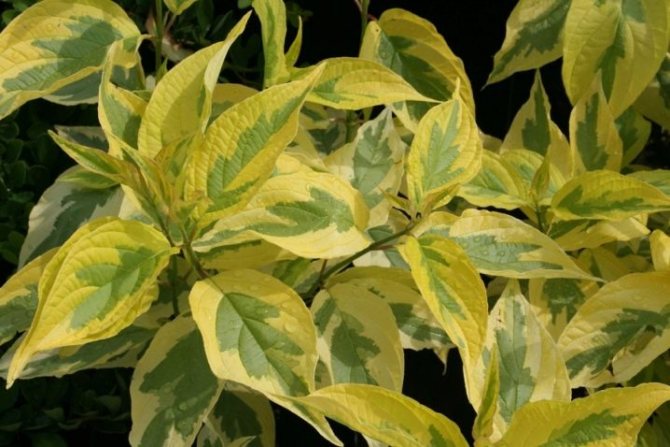

- "Cream Cracker". Quite an exquisite, upward shrub, from which standard trees are usually formed. The edging on the leaves is light beige, in autumn it changes its color to lilac.
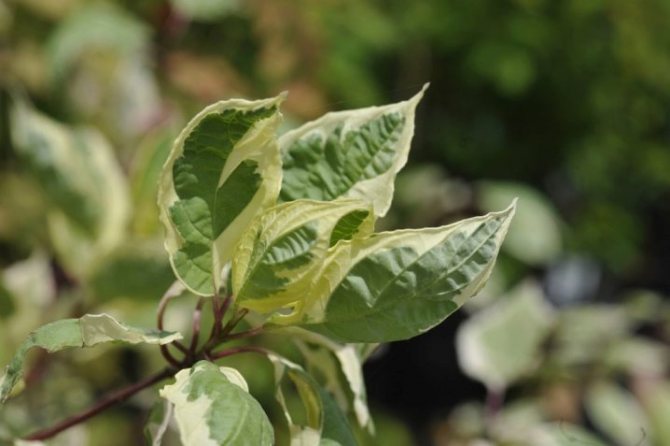

- "Spaethii". This variety was bred about a hundred years ago. The leaves have a golden yellow edging that sometimes covers most of the plate. Young leaves are orange, and in autumn they change color to purple, almost purple. The plant grows rapidly - the annual growth is 20-25 cm, it is resistant to frost and heat.


- "Argenteomarginata". A fairly tall tree, growing up to 3 m, the leaves are elongated (up to 10 cm), silvery yellow, the border is milky. In winter, the foliage changes color to lemon or brick. The berries are dark yellow with a slight bluish tint.
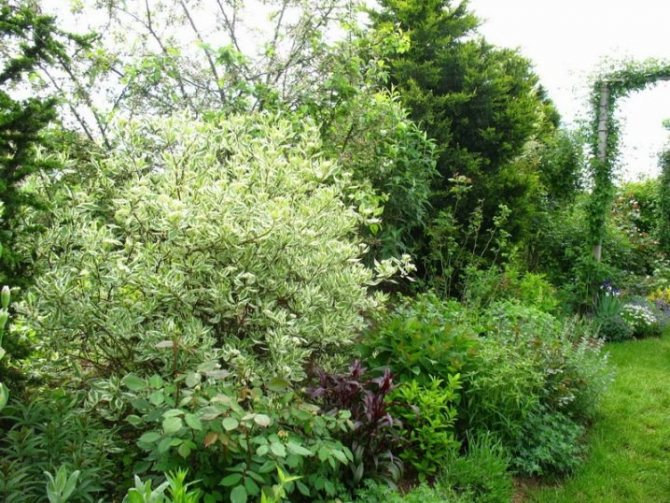

- Ivory Halo. A low-growing plant, does not grow more than 1.5 m, the crown is spherical, and takes the desired shape even in the absence of pruning. The foliage is light green, the edging has a shade of eggshell. Scarlet bark, as it develops, changes color to brick.
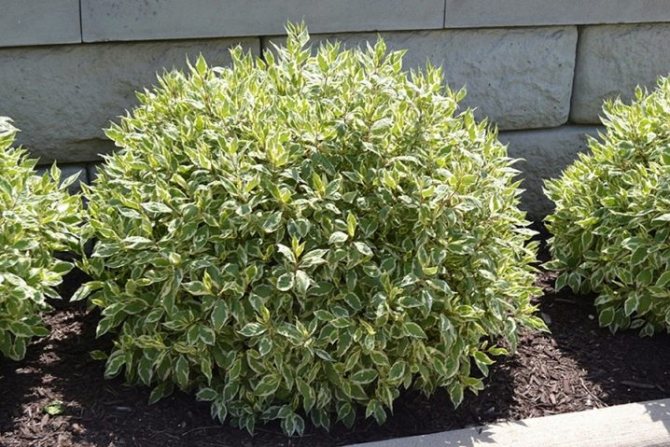

- "Kernii". The shrub grows up to 2-3 m, has an unusual burgundy bark, leaves of lime-lemon color, a border of bright yellow and beige tint.
- Westonbirt. The shrub reaches a length of 1.5 m, is distinguished by pink leaves and coral shoots.
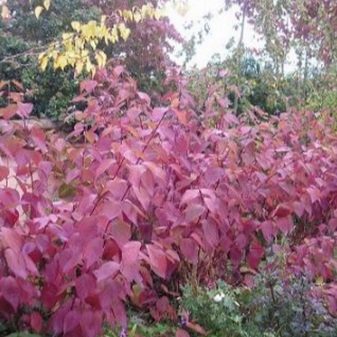

- A very popular variety - "Compress" - it has crimson shoots and red leaves, so it has a very decorative and exotic look.
Description
Derain white is the most popular culture, which is grown in our latitudes. Since it adapts well to harsh climatic conditions. The branches, depending on the type, are red, red-brown or brown, they are spreading and quite flexible, creating a gorgeous crown, reaching 2.5 meters.
The plant blooms twice a year: May-June, August-September. It is decorated cream flowers, collected in fluffy inflorescences, in the fall, each flower turns into a ball. They can be white, red-gray, or black. Against the background of bright green, orange or purple foliage, they look just great. You might think that along with the leaves, all the beauty of culture will disappear, nothing like that! In winter, the shoots of the bush acquire a very decorative and interesting color. They can be dark green, yellow and even coral, which looks very impressive... In the photo you can appreciate the beauty of the culture.
In the next article you will find out everything about growing and caring for pear Forest beauty.
Landing subtleties
It will be correct to plant grass in the spring, since in this case the plant will have the opportunity to grow up over the summer, get stronger, and already prepared and full of strength to go to the first winter. In order for the dogwood to grow healthy and attractive and delight its owners for many years, it is necessary to choose a planting site, prepare a plot of land and purchase suitable seedlings. It is best to give preference to sunny areas. The plant can develop in the shade, but in this case, the color of the leaves loses its brightness and decorative effect. Also, do not plant a bush in places with a high level of groundwater - excess moisture leads to decay of the root system, which, in turn, leads to the death of the plant.
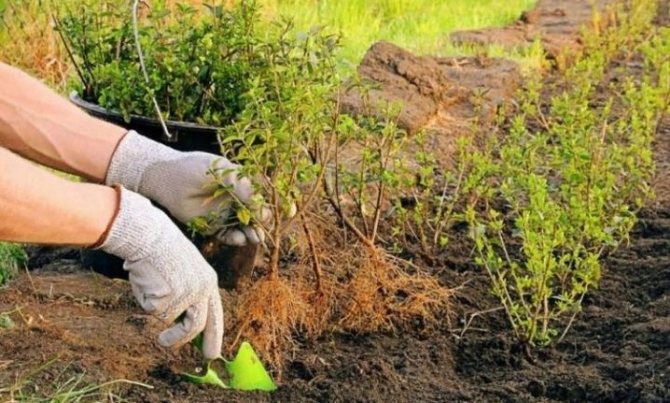

The seat should be well prepared. First you need to remove all the weeds growing there, dig up the ground and apply fertilizer. If the place is swampy, then you should arrange a drainage system in advance. Derain grows well in sandy loam soil that allows water to pass through. The best option would be to use acidified soil with a small amount of lime; moist fertile soils are also suitable.
It is best to use seedlings up to 4 years old, obtained from cuttings, as the main planting material. In this case, the young plant will fully acquire all the features and characteristics of the mother plant. Only healthy seedlings should be planted without visible damage to the root system and stem. The foliage should be rich in color. If the roots of the tree are windy, then before planting they should be placed in a bucket of water for several hours. If desired, you can add a little root stimulant solution.
The planting procedure is as follows.
- The topsoil should be removed from the plot of land where the turf is planned to be planted. The removed soil is mixed with sand and humus in equal proportions.
- Then fertilizers are applied. It is best to take granular combination preparations at the rate of 100 g per 1 sq. m. plot.
- The pit is usually made large and deep. If the soil is swampy, then a layer of brick or medium-sized stones must be placed on the bottom.
- The bottom of the planting pit is covered with humus and sand and about 5-7 liters of water are poured into it.
- The seedling is placed in the hole, the roots are gently straightened and covered with the prepared soil mixture to the level of the root collar. If it is located too high, then the bush will give too many weak shoots, which will inevitably lead to the death of the plant.
- For group planting, a distance of 1.5 m should be observed between the bushes.
- After the end of planting, the earth is tamped, the surface is covered with mulch from sawdust, pine needles and peat.
Derain variegated with its appearance is able to attract at any time of the year. In summer, the bush is covered with a hat of bright leaves; in winter, colorful branches attract the eye. Derain is increasingly used in landscape design: as a living fence, they decorate gardens and alleys. Many are inclined to assume that this name was derived from the rather tough wood.
Derain purple-red: characteristics of the species and popular varieties
City dwellers want to see beautiful parks and well-groomed house plots in their city. In the spring they go out to cleanup clean-ups, plant new trees and shrubs. Deer seedlings are very suitable for such works, they are not expensive, but they have all the necessary qualities for landscaping:
- the roots of the plant take root very quickly and well in any soil, the root system gives a lot of shoots, so the red dogwood is easily propagated by dividing the bush;
- young shoots are light green in color, which later becomes brown;
- the leaves are green, medium-sized, ovoid; closer to autumn they become blood-red, the surface of the leaf plate resembles crushed glossy paper with pronounced veins;
- red derain Compress is a decorative type, therefore it does not form peduncles and does not bloom;
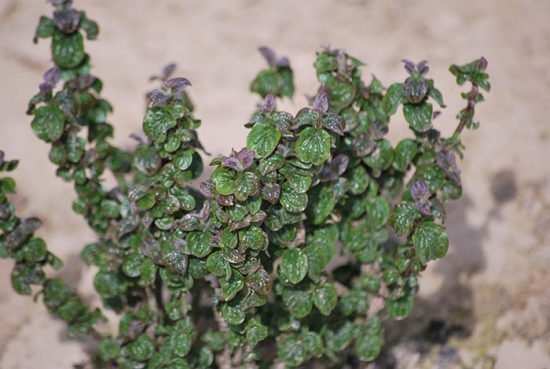

- the plant is winter-hardy and drought-resistant, grows well both in sunny open areas and in a shaded place;
- care is minimal, not requiring much time and labor.
Some of the most popular varieties are:
- Compressa - erect shoots, leaves are compressed, their edges are bent down towards the shoots.
- Variegata - green-brown branches are able to change their color to red in the sun, and the fleecy leaves turn purple in autumn.
- Midwinter Fier - the main color of foliage and shoots is red with an orange tint.
The most striking representative of this species is the blood-red Compressa dogwood, we will tell about it in more detail. The photos shown here show this variety of deren. Also, our recommendations for caring for him may be useful to you, and the reviews of readers who have experience in growing deer will help determine how you can use his planting in landscape design.
Advice. Seedlings should be purchased in nurseries that have proven themselves only from the good side; you should not trust random sellers who trade in spontaneous markets. Their plants can be infected with dangerous diseases that cause a lot of trouble.
Description of variegated sower
Derain grows in Siberian, Far Eastern and Asian forests. This shrub belongs to the dogwood family, in height Variegated Derain can reach up to 3 m.
The bush has a large number of straight branches that form a spreading crown, Derain itself is strong, has a brown-red tint. Since there are a large number of varieties, you can find small shrubs, the height of which does not exceed 1.5 m.
The leaves are large, green in color, along the edge there is a border, which comes in 2 colors - white, yellow. Inflorescences are snow-white, up to 6 cm in diameter. Flowering can be observed twice a year. The fruits that appear in the fall are inedible and blue in color.
A distinctive feature is resistance to low temperature conditions, unpretentious care, which makes it possible to use Derain even in the Northern regions.
Derain in garden design
When decorating landscape design, the lawn can occupy both the main place in the garden and be located in the background in combined plantings. Under the bushes, ground cover perennials, contrasting in color, are often planted (aubrieta, rejuvenated, stonecrops, herbal cloves and others). Derain yellow (Aurea) looks great in the undergrowth of birch groups. A solid carpet of creeping varieties will be an excellent decoration for slopes, empty plots of land, ravines.
A low hedge made of bush turf will allow the garden to be delimited into functional zones, to cover the area from dust and wind, to disguise unsightly buildings, fences, walls. Low-growing plants of the dogwood family are suitable for decorating an alpine slide.
Variegated varieties thrive where other crops fail. They are combined with some types of barberry, roses, low conifers and plants of the honeysuckle family. Variegated forms will originally complement the plantings with white snowberry and white-fruited mountain ash.
All varieties of deren can be used to decorate the territory, creating a favorable atmosphere for a good rest, and the ease of maintenance allows even a very busy gardener to grow culture.
Derain variegated in landscape design
Thanks to the wide variety of varieties, you can create a wonderful decoration for your homestead. Typically, the shrub is used to create a hedge, giving it a variety of shapes. Derain looks great next to juniper and barberry.Looks impressive with small flowering shrubs.
With the help of Derain, they carry out zoning of territories. The shrub can be planted not only in groups, but also individually. For example, if you plant this plant on a lawn, then a tall bush can become a kind of landmark.
Compatibility with other plants
Derain is a rather sociable species that allows you to plant other types of plants in the immediate vicinity.
The bush looks decent both when planted solo and in combination with other plants or tightly planted.
Variegated and colorful types of deer are successfully combined with both deciduous and coniferous plants. The bush can serve as a background composition for both perennials and annuals.
An example of such compatibility can be blooming multi-colored chrysanthemums against the background of a growing hedge made of deer.
Varieties of variegated deren
Derain includes a wide variety of varieties. It is impossible to say that there are a lot of existing species, but despite this, every gardener, even the most whimsical, will be able to choose exactly what he wants for himself. A distinctive feature of all types is unpretentious care and attractive appearance. Most often, a hedge is made from Derain variegated, giving decorativeness in various forms.
Elegantissima
This variety is considered the most common; it can be found more often than others in garden plots. This type is ideal for single plantings. As a rule, the height of the bush reaches 2.5 m. The shoots are straight, coral in color. The leaves have pointed tips, while they are slightly concave along the central vein. Mainly there is a green color with a bluish tint. The border on the leaves is small, sometimes white and light green. During the flowering period, flowers appear in delicate pink tones.
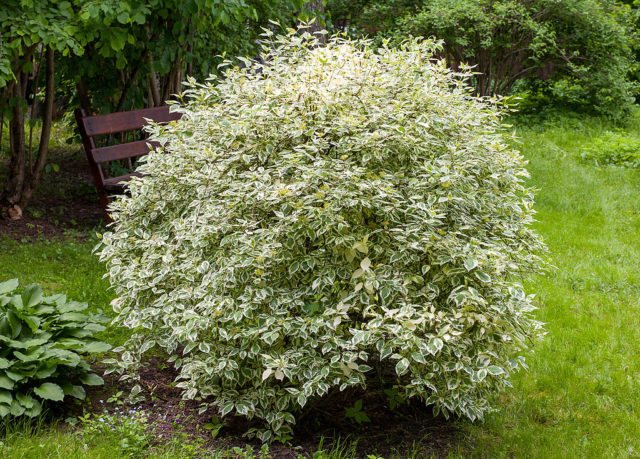

Sibirica variegata
The shrubs of this variety are medium in size, reaching a height of up to 1.5 m, but most often up to 1.2 m. The branches are bright enough, with a rich scarlet color. The leaves are elongated, flat, light green in color. There is a white border around the edge. In the autumn, the colors become more saturated, purple, with a purple tint. The flowers are green, the fruits are blue, and there is a bloom of wax on them.
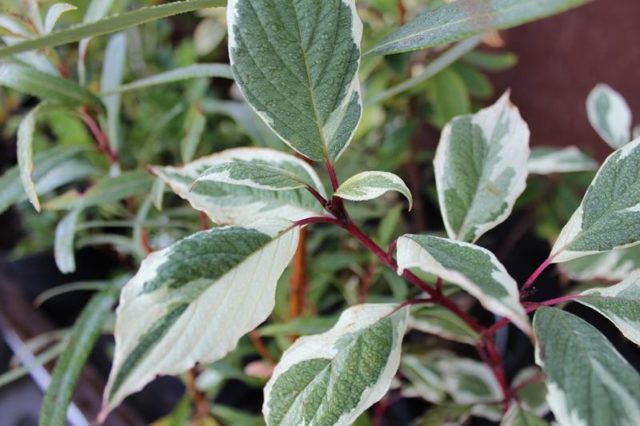

Gouchaultii
Gouchaultii is rather massive and at the same time squat. The height of the bush reaches up to 1.5 m. The shoots are very flexible, long, dark scarlet in color. The border on the leaves is wide, while uneven, lemon shade. If you plant this species in a sunny place, then the foliage will cast pink. During the flowering period, yellow flowers appear, which are replaced by blue fruits.
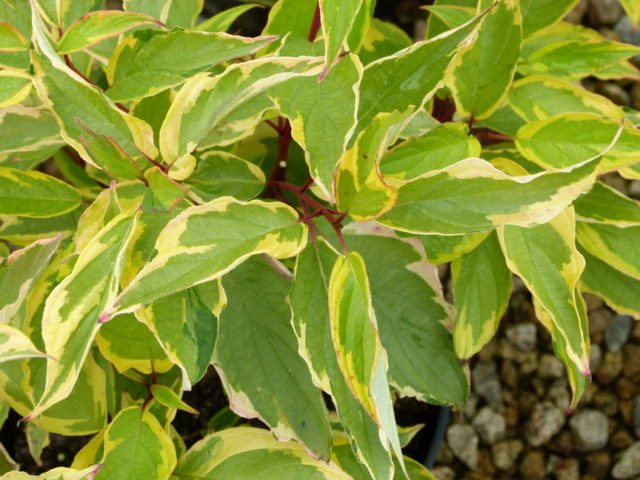

Ivory Halo
Ivory Halo is a novelty recently introduced by breeders. The bush grows up to 1.5 m in height. If the crown is not trimmed, then over time it will become the correct spherical shape. The foliage is light green with an ivory border. The young bark is deep red, gradually becoming a brick shade.
Aurea elegantissima
The height of the bush reaches 2 m. Initially, the leaves are brick-colored, over time they turn yellow. This variety has the widest leaves, rounded, matte. In autumn, a red tint appears, but the color itself does not change. If you grow the shrub in a sunny place, then a brown border appears on the leaves. The level of frost resistance is much lower than that of other species.
Cultivation of culture
Derain white belongs to unpretentious plants, therefore it can be planted and grown even by novice gardeners. The shrub can be planted in any soil, it treats sandy, heavy and loamy soils equally well. It tolerates unfavorable conditions such as drought, severe frosts and others calmly. Also, white-bordered dogwood is resistant to most diseases and unattractive to pests.But despite these positive points, there are still some rules that should not be neglected when planting a culture.
If you want to get a beautiful bush, you should:
- Plant in sunny places. The shrub will grow more actively, will delight with bright colors.
- Before planting, fertilize the soil with microelements. The cuttings will take root better and will grow more actively.
- If the site has swampy soil or is located near water bodies, drainage must be done, otherwise the roots will begin to rot.
How to plant variegated dogwood
Planting and caring for Derain is not as difficult as it might seem at first glance. In order for an attractive ornamental shrub to grow, which will delight with its appearance for many years, you will need:
- choose the right place for landing;
- pre-prepare the soil;
- choose suitable seedlings for planting.
If you grow the plant in partial shade, with a minimum amount of moisture, then the leaves will lose their brightness. In turn, excess moisture leads to rotting of the root system. If necessary, you can look at the photo of planting, care and pruning of Derain variegated.
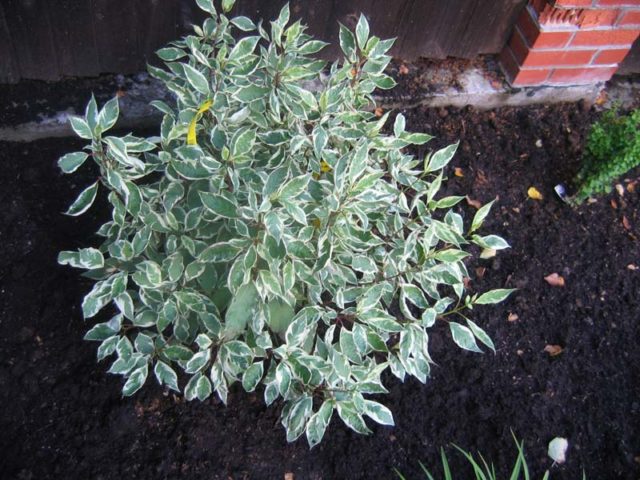

Soil preparation
Before planting a plant in open ground, it is necessary to prepare a planting site in advance. Pre-select a suitable place where the shrub will grow, remove existing weeds, add fertilizers to the soil. If the place is swampy or there is groundwater near the site, then you need to take care of drainage.
Derain grows well in sandy or sandy loam soil, with good water permeability. It is best to use acidified soil with a little lime. Fertile moist soils are of particular importance.
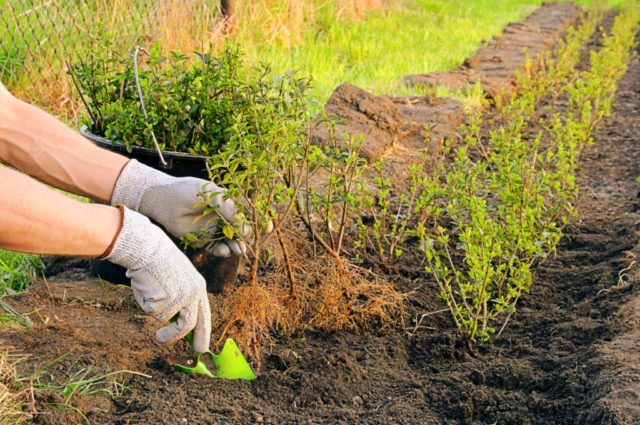

Preparation of planting material
Experienced gardeners recommend using seedlings that were grown from cuttings as planting material. This is due to the fact that such planting material retains all the properties and characteristics of the mother bush.
It is necessary to choose healthy seedlings that are free of damage, the foliage has a bright saturated color, and Derain is no more than 4 years old.
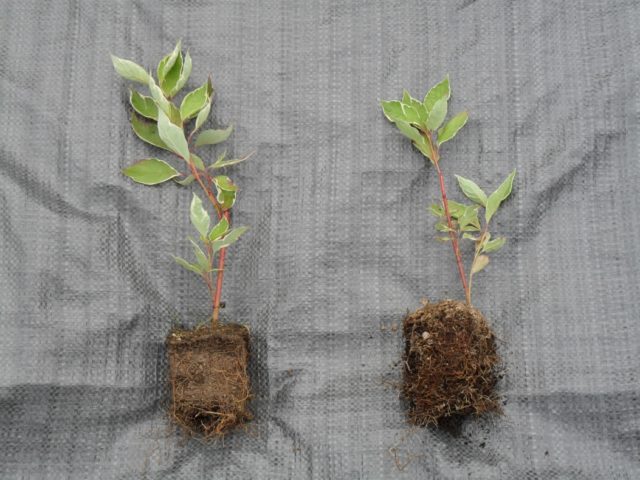

Planting variegated deren
Derain variegated planting is carried out in the fall. The work algorithm is as follows:
- From the place where the bush will grow in the future, it is necessary to remove the top layer.
- The removed soil is mixed in equal proportions with sand and humus.
- After that, you need to add fertilizers, which are produced in granules. For 1 sq. m takes 100 g of the drug.
- In order for the shrub to have a lot of free space for growth, it is necessary to make large pits. In the event that the soil is swampy, you will need to place broken building bricks or stones of the middle fraction on the bottom.
- Prepared soil with sand and humus is poured into the bottom of the pit.
- Pour in about 6 liters of water.
- The roots are gently spread along the bottom of the pit.
- Top covered with the remaining earth. The root collar must be flush with the soil surface. If the root collar is too high, then the shrub will give a large number of weak shoots, which will lead to death.
For group planting, the distance between the bushes should be 1.5 m, if the planting is single, then a support will be required.
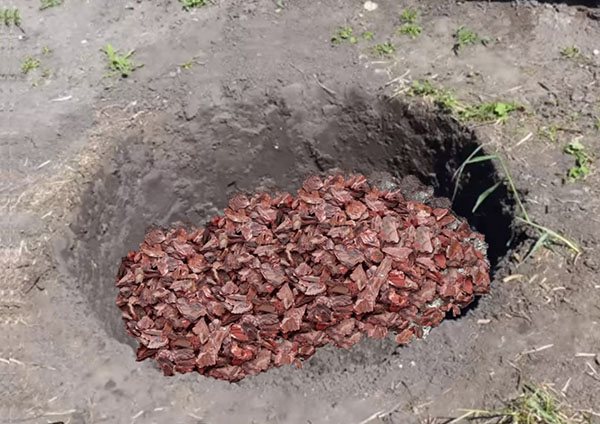

Derain white reproduction
An unpretentious plant is propagated in two ways:
- Seeds,
- By cuttings.
How to propagate by seeds?
This method is considered to be slow and is often only used on a large scale. But if you still choose this method, then you need to take into account the following points:
- The seeds are harvested at different times, as they ripen at different times.
- The collected seeds are stored for up to 5 years in signed paper envelopes or small boxes, the date, collection period, variety are indicated. The place must be dry.
- Planting is done in early spring or late autumn.
- Before sowing, the site is fertilized and well dug up.
- Before spring sowing for 2-3 months, the seeds are kept in a special substrate of sand, moss, peat and sawdust at a temperature of +5 degrees. One part of the seeds is taken for four parts of the soil. If sown in the fall, the seeds are used fresh without stratification.
- To ensure good germination, you need to take 5-15 g of seeds per 1 square meter.
- Sowing depth no more than 5 cm.
- Crops are regularly cleared of weeds and watered.
- With proper planting, the plant will grow as much as possible after 5-8 years. Fast growing varieties will reach their apogee in 2-3 years.
- The seedlings are planted in a permanent place when they are about 60 cm.
Cuttings are a quick way to reproduce:
- A strong adult shrub with lignified shoots is selected and cuttings are cut. It is better not to take young shoots, as they may not take root.
- Cuttings are cut in June and planted immediately.
- The soil must be dug up in advance and treated with fertilizers.
- Small grooves 15-20 cm deep are dug. Sand and peat, taken in equal proportions, are poured onto the bottom.
- Each stalk sinks to the very bottom of the groove near the side wall.
- The distance between the cuttings is from 10 to 15 cm.
- They are sprinkled with soil in 2 or 3 approaches, pressing each layer well.
- The seedlings are watered abundantly.
- The compost near the cutting is well compacted.
- It is impossible to check and remove the cuttings from the soil. The buds that have appeared will tell that the cutting has a root.
- The cuttings are planted in a permanent place after a year and a half.
How to care for variegated dogwood
Caring for Variegated Derain consists in timely watering, pruning and fertilizing for growth. Top dressing is applied annually, 2 times. In the spring, mineral complexes are used as fertilizer, in the summer there is enough humus, which allows the near-stem part not to dry out.
Despite the fact that Variegated Derain perfectly tolerates low temperature conditions, young bushes must be covered for the winter, as they may die. The most problematic of all is to cover the green hedge.
Since pests do not prefer these plants, they can be seen extremely rarely. As a preventive measure, treatment with soapy water can be carried out.
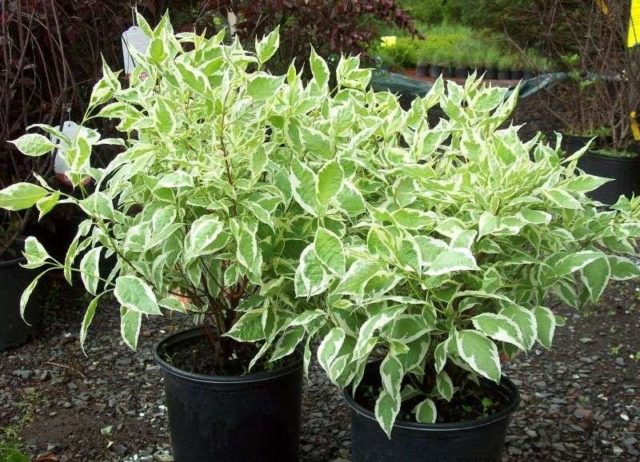

Watering and feeding
Green-yellow Variegated Derain needs proper planting and maintenance. Do not forget about timely watering and fertilization. Young shrubs need to be watered daily with a little water. During a drought, mature plants are watered twice a week. As a rule, each bush takes up to 20 liters of water. When the soil is wet, the amount of watering is reduced.
An adult Derain needs annual fertilization - they do it 2 times. The first feeding falls on the spring (April), for this they use mineral fertilizers, about 200 g per bush. In the summer, in August, organic fertilizers are taken; chicken manure or compost in an amount of 5 g per bush is suitable for these purposes.
In order for Derain to grow quickly in the first year, it will be necessary to apply complex fertilizers quite often. Root and foliar dressings alternate at the same time. To give a bright color and achieve abundant flowering, rotted leaves are poured to the roots.
Pruning variegated turf
Derain fell in love with landscape designers, as a result of which it is used in decoration as a central figure. Due to its attractive appearance, it can fit into any ensemble.
This shrub can be cut, thereby giving it any shape. Pruning should be done several times throughout the year. First of all, dry and old branches are removed, after which they proceed to cutting off excess growth and stems sticking out in different directions. If necessary, you can completely cut the bush, after a while the formation of new shoots and shoots will begin.
If you use Derain to decorate arches and fences, then they can be shaped like arcs and columns.To prevent the plant from growing, it is necessary to remove unnecessary shoots in a timely manner.
Preparing for winter
Derain variegated, growing in the garden, needs special winter preparation. As a rule, young cuttings are left for the winter in a greenhouse, using temporary soil for this. It is not necessary to cover adult plants; they tolerate low temperatures very well.
In the fall, the amount of watering is reduced. Closer to winter, the shrub sheds foliage, which allows it to survive the cold season. If the plant has already been planted in open ground, then it should be covered with dry leaves, sawdust, and rags. With the onset of heat, the shelter is removed.
Pruning deren in spring
Pruning is an important step in the maintenance of your lawn in your garden. The procedure helps to preserve the decorativeness of the varieties, maintains their compact shape and the required height in the hedge.
Derain in winter
Young shoots have the brightest and most intense color, old branches gradually turn brown and lose their attractiveness. Many gardeners prefer to remove 20-25% of the oldest stems in the month of March each year to maintain the winter decorative color of the bushes.
As an alternative to annual pruning, you can prune old stems every 2-3 years, leaving only 15-30 cm above the ground. This method stimulates the growth of new shoots well, but do not expect flowering in this case, since flowers are formed only on a two-year growth.
Wood ash as plant fertilizer - composition, application and benefits
Young seedlings begin to be cut only 2-3 years after planting, when they are fully strengthened. In variegated turf varieties, some branches may form completely green leaves, which are best removed. Tree-shaped varieties and ground cover species do not need to shorten the shoots.
How to form variegated dogwood
Derain variegated haircut is carried out several times throughout the year - at the beginning and at the end of summer. If Derain is not cut off in time, then the lower branches begin to gradually become bare, which only spoils the appearance. It is necessary to constantly monitor the formation of branches on which solid leaves appear. Such branches should be removed immediately.
Formative pruning is used when the plant is used as a hedge. This is necessary in order to preserve the original form. Also, do not forget about sanitary pruning, during which damaged, sick and old parts are removed.
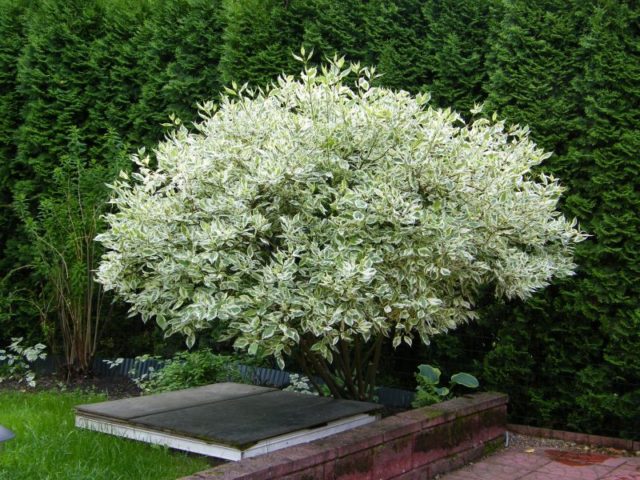

Plants for gardens and parks: Red Derain Compressa
Among the monochromatic green bushes, fiery "bonfires" with crimson foliage and red twigs suddenly appear. This is the Red Compressa tree. Among the many species of deren, it is the most extraordinary, it attracts attention both by the shape of its foliage and by its autumn crimson color. Landscape designers love this unpretentious shrub for its ease of propagation, planting and maintenance, and for its resistance to winter cold. These qualities of deren make it possible to use the shrub in almost any design solution: in the design of hedges, for compacting the earth near park paths, for creating free-standing compositions.
Read also: Hawthorn: benefits and harms to the body, how to take?
How to propagate variegated dogwood
Many gardeners prefer vegetative propagation. This choice is due to the preservation of the properties and characteristics of the mother plant, while the bush can be formed in several years.
For propagation by cuttings, planting material is harvested from adult bushes, cutting off the shoots, and then rooting them. Most of the time is spent growing from seeds.
Reproduction of variegated turf by cuttings
Variegated Derain is propagated by cuttings in the fall. For planting, it is worth choosing last year's branches that bend well and have already matured wood.Green growths are preliminarily removed, leaving only strong shoots.
On a cut cuttings, there must be 3 pairs of buds. The lower foliage is completely removed. In order for the planting material to take root, it is placed in water, after which Derain can be moved to the greenhouse before the onset of heat, when the shrub will be planted in open ground.
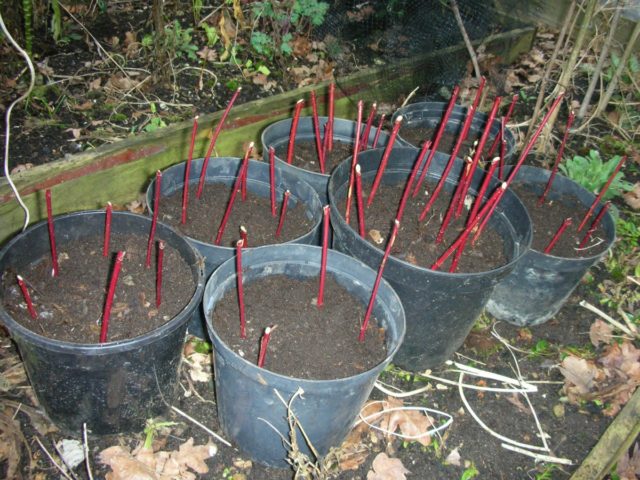

By dividing the bush
Derain can also multiply by dividing an adult bush. For these purposes, strong and healthy plants are chosen. You will first need to dig them up and carefully use a shovel to divide the rhizome into several parts.
This procedure looks like this:
- Dig out a bush.
- Shake off the ground from the roots.
- Using a sharp knife or shovel, divide the root part in half.
- Each part is buried separately.
Before planting Derain, you need to put fertilizer on the bottom of the hole.
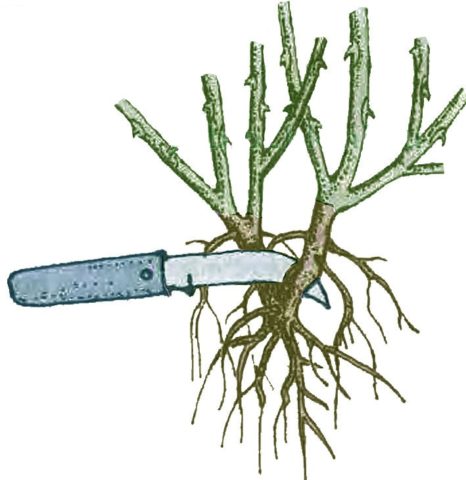

Layers
Another breeding method is rooting by layers. Due to the fact that the branches grow fast enough and tend to the ground, they can be easily rooted. In spring, the branches closest to the ground are buried in the ground and securely fixed. A year later, such a seedling can be safely dug up and transplanted to another place. Derain will take good roots in 6 months.
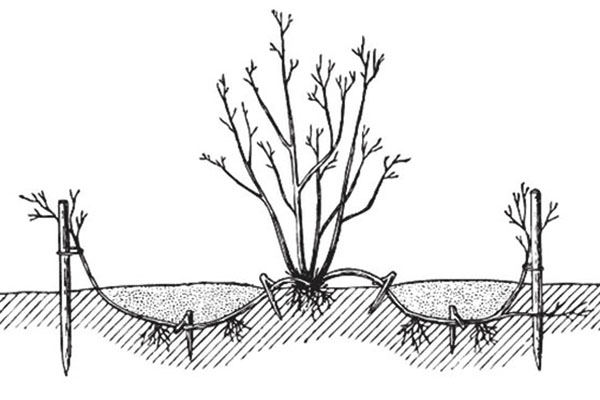

Seeds
After the flowering period is over, clusters with fruits, inside which there are seeds, appear on Derain variegated. Flowering occurs between May and June. In autumn, the accumulated seeds are carefully collected and sown until the first frost occurs.
If the seed is planted in spring, then it must be placed in a cool place for 6 months at a temperature not higher than + 5 ° C. Hardened seeds have a much higher germination rate.
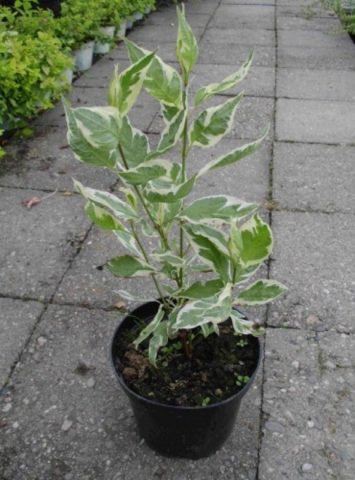

How to root variegated dogwood
In the case when grafting is chosen as propagation, the planting material must be rooted before being planted in open ground. First of all, after planting material has been cut from an adult Derain bush, it is necessary to place the cuttings in cold water. Thus, the first roots will begin to appear. To speed up the process, many gardeners recommend using special means - rooters, with their help they process the root system, after which the Variegated Derain is planted in open ground.
Reproduction of deren by cuttings in spring
The culture propagates very easily by lateral layers, horse suckers and cuttings. The best time to propagate cuttings is at the end of the flowering cycle. A suitable stem must break when bent.
Cuttings with 2-3 internodes are cut below the leaf buds at an angle of 45 degrees. It is better to remove the leaves. The lower part of the cuttings is first dipped in water and then in a hormone that stimulates root growth. Planted in a pot with a mixture of sand and perlite or universal soil and sand (1: 1).
Spray water onto the soil and cuttings and cover with a clear bag. The pot is placed in a shady place in the garden. Rooting is possible by maintaining a constant average moisture content of the substrate.
It usually takes about 6 weeks for rooting. As soon as signs of new growth appear, the bag can be removed, and the seedlings can be placed in a place with bright diffused light.
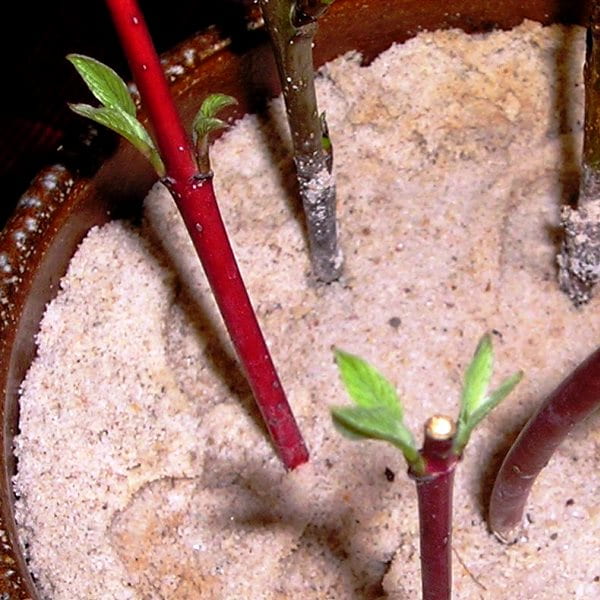

Rooted cuttings
Water the plants regularly and use liquid fertilizers, but at only half the dose. Grown up seedlings with well-formed leaves and roots are transplanted into a larger pot with a fertile mixture and left for the winter in a cool room. Planted in open ground at the end of spring.
19 unpretentious flowering perennials
Wood cuttings can also be harvested in late autumn and stored in the refrigerator in a sealed bag with damp sand throughout the winter. In the spring, rooting technology is the same as described above.
Why do the leaves of the variegated deer turn black and dry
Very often, gardeners are faced with a problem when the leaves of Derain variegated begin to dry out and become covered with black dots. These symptoms indicate that the bush has undergone a fungal disease. To combat rot, the following drugs are used:
It is recommended to reduce the number of waterings during processing. Also, black spots on the leaves appear when Derain variegated is watered with cold water.
Important nuances of caring for variegated dogwood
Dogwood variegated - a plant from the "planted and forgotten" category. Many gardeners do just that. But in order for the shrub to retain its decorative effect and develop normally, a minimum of time and effort will still have to be spent on it.
The main thing a plant needs is regular pruning. Specimens with thickened, "bald" branches sticking out in different directions look very unpresentable. Dogwood tolerates the procedure well, even if the gardener overdoes it a little. During the active growing season, depending on the growing conditions of dogwood, it adds 30–100% of the green mass.
The uncontrollably growing bush of variegated turf looks rather untidy
The first time pruning is carried out at the beginning of the third season after planting in open ground. No more than a third of all shoots are removed, leaving the most powerful and developed ones.
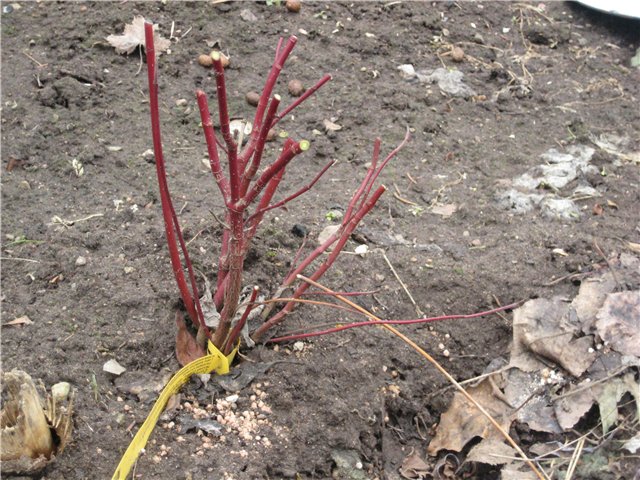

The turf bush tolerates pruning, including radical pruning, practically without damage
The procedure is carried out in early spring, before the start of active sap flow, but always at above-zero temperatures. The exception is hedges, which are formed twice a year, in July and September. For this they use extremely clean, sharply sharpened and disinfected tools - knives, scissors, secateurs. All "wounds" must be carefully covered with garden varnish, after washing with 2% copper sulfate or a bright pink solution of potassium permanganate with the addition of crushed chalk and any fungicide.
Turf pruning is carried out when the plant has completely lost its foliage in the fall or has not yet "woken up" in the spring
As for the configuration, here the gardener is limited solely by his own imagination. The variegated turf bush can be given any, the most incredible outlines. Not least for this it is appreciated by landscape designers. Although many people prefer to just slightly correct the natural shape.
Be sure to get rid of broken, leafless, dried, deformed, twisted shoots. Those that grow inward, thickening the crown, or downward also look bad.
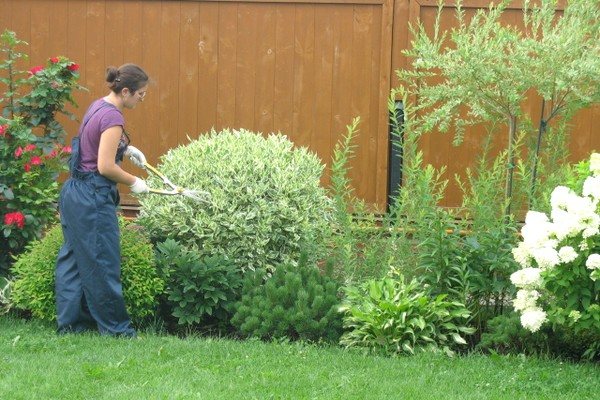

Only disinfected instruments are used for trimming the turf.
Variegated dogwood belongs to the category of plants - "chimeras". Their tissue cells differ at the genetic level. Therefore, sometimes a gardener can find monochromatic green leaves on shrubs with an initially variegated color. Together with the shoots, they must be removed in a timely manner, because they are genetically stronger. If you do not prune in time, the variegation will soon disappear altogether.
Video: trimming the turf
Young plants and transplanted adult specimens need daily moderate watering during the first week after the procedure. In general, variegated dogwood tolerates drought and heat without much damage to itself. Powerful roots draw moisture out of deep soil layers. Adult plants are watered at the root once a month. If there is a strong heat for a long time, and there is no precipitation, the intervals between procedures are reduced to 5-8 days. Water consumption rate - 20-25 liters. By autumn, watering is gradually reduced.
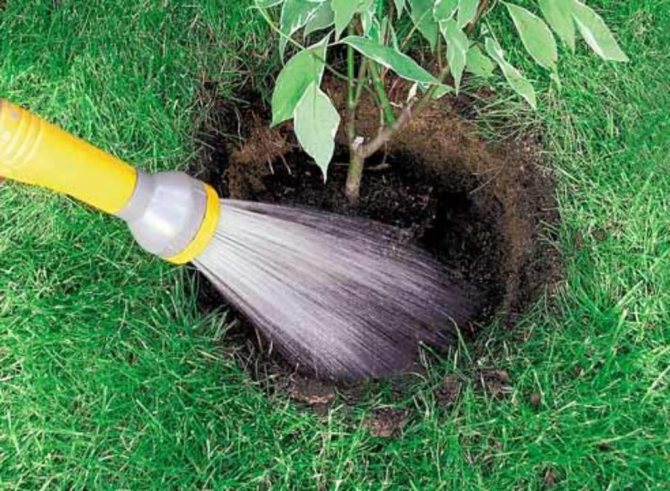

The variegated turf bush does not need frequent watering, the root system may well provide the plant with everything it needs, including moisture
Top dressing is applied twice during the growing season, in spring and autumn. In the first case, a complex mineral fertilizer containing nitrogen, phosphorus and potassium (Azofosk, Diammofosk, Nitrofosk) is used.For an adult plant, 200 g is enough. Once every 3-4 years, you can pour a bucket of humus or rotted compost under the bush, mixing it with the soil in the process of loosening.
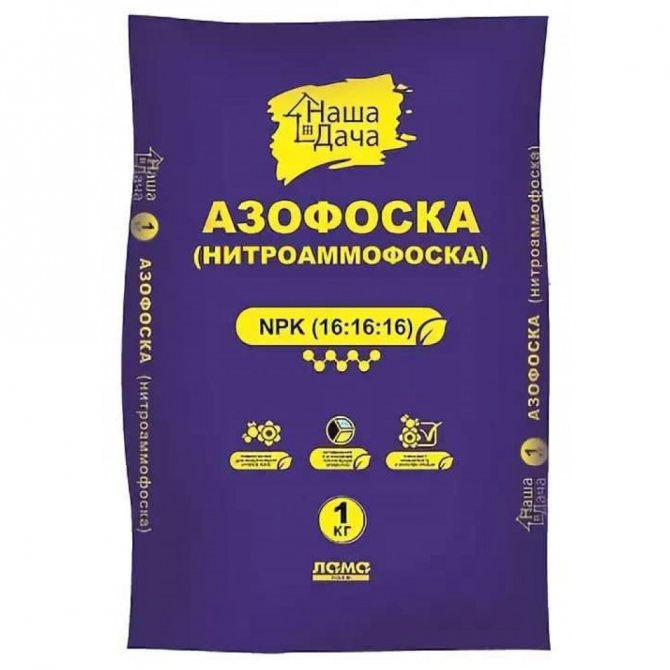

Azofoska is a common nitrogen-potassium-phosphorus fertilizer
In the fall, the tree needs phosphorus and potassium. The natural source of these macronutrients is wood ash. It is poured dry to the roots if it is rainy. When there is no precipitation for a long time, an infusion is prepared - a half-liter can of raw materials for 3 liters of boiling water. You can also use complex fertilizers without nitrogen, for example, ABA, Autumn.
Wood ash - a natural source of potassium and phosphorus
During the active growing season, if desired, about once a month, you can feed variegated turf bushes with natural organic matter. Infusions of fresh cow dung, chicken droppings, nettle greens, dandelion leaves are suitable for this. In general, any weeds growing in the garden can be used as raw materials. They are crushed, filled in about a third of the deep container. The remains are topped up with water. The container is tightly closed and left in direct sunlight for several days. The fact that the fertilizer is ready is signaled by the characteristic “aroma”. Before use, it is filtered and diluted with water in a ratio of 1: 8. If the product was based on droppings, it will take twice as much.
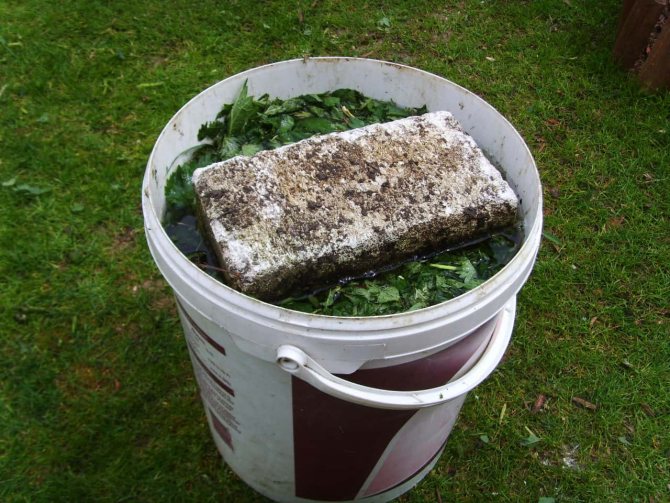

Nettle infusion is a natural and absolutely free fertilizer
To increase the growth rate, it is useful to feed young (1–2 years old) plants with store-bought complex mineral fertilizers, alternating root and foliar feeding. The solution is prepared according to the manufacturer's instructions given in the instructions.
Only young variegated turf plants under the age of five years need special preparation for winter. Adult specimens tolerate even severe Ural and Siberian frosts without much damage to themselves.
The soil in the near-trunk circle is cleaned of plant debris, loosened. The mulch layer is renewed. It is advisable to use humus or peat chips. At the roots, its thickness is 10–15 cm, on the rest of the area, 5–6 cm is enough. If the size of the shrub allows, it is covered with a cardboard box of a suitable size. Shoots can be gently lifted and tied up from the bottom for more compactness. The box is stuffed with straw, fallen leaves, wood shavings, crumpled newsprint.
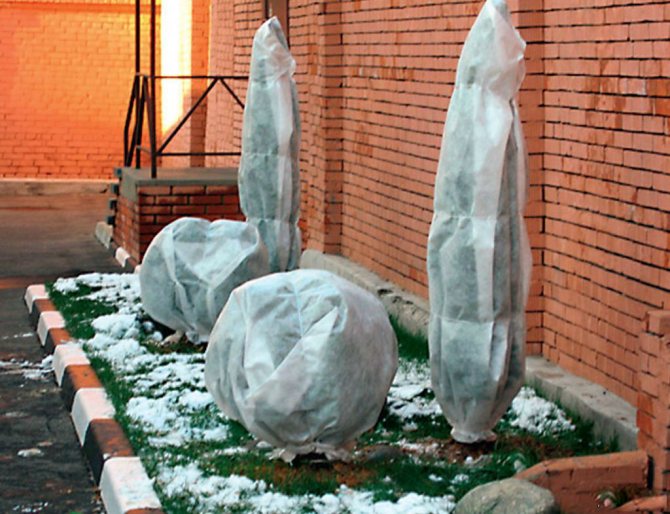

Only young bushes of variegated turf need special preparation for wintering.
Another option is to build a structure like a hut. Poles of suitable height are used as a frame. Several layers of burlap or other air-permeable covering material (agril, lutrasil, spunbond) are pulled over them.
Video: the experience of growing variegated turf
Diseases of variegated turf
The Derain variegated shrub is classified as a problem-free plant. This is due to the fact that it is quite difficult to ruin it. Most often, Derain is attacked by root rot, but it should be borne in mind that the appearance of this disease is personally allowed by the gardener. Root rot appears if the shrub is watered often and a lot.
A second common problem is loss of leaf tone. This phenomenon is associated with a moisture deficit, usually during a drought. If you water the plant several times, then everything will return to normal.
Planting procedure and preparation for it
Unpretentiousness extends to the conditions of planting and caring for variegated dogwood. The plant tolerates almost any quality substrate, including saline, acidic, and alkaline. The only thing that categorically does not suit him is groundwater, located closer than one and a half meters from the soil surface. This can provoke the development of root rot. For the same reason, it is undesirable to plant dogwood in a clay, peat, or silty substrate that easily sours.The ideal option for a shrub is a fertile soil that allows water and air to pass through well.
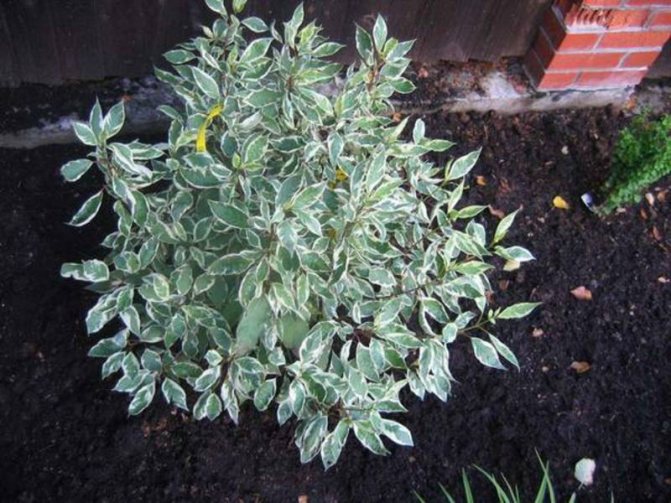

Dogwood variegated will suit almost any place in the garden
The plant feels good both in the shade, and in partial shade, and in the bright sun. This does not affect its development. But over time, especially in the absence of proper care, the variegation of the leaves can fade to uniformity both in direct sunlight and with a lack of light.
The root system of variegated turf is quite powerful and developed. Therefore, it is advisable to place the shrub away from plants with superficial, fibrous roots. He can simply "strangle" them or deprive them of nutrition, drawing water from the soil, the necessary macro - and micronutrients.
The planting procedure is most often planned for the spring. In regions with a temperate climate, this is generally the only possible option. Only in this case can it be guaranteed that the plant adapts to new habitat conditions before the first frost and forms a sufficiently developed root system that will provide it with everything necessary for wintering.
The culture is deservedly considered frost-resistant, but with planting it is recommended to wait until the air warms up to 12-15 ° C, and the soil - up to 8-10 ° C at a depth of 10-12 cm. The specific disembarkation time depends on the climate in the region. It can be mid-April or late May. You can focus on folk signs - birch leaves that have begun to bloom, dandelions in bloom.
The landing pit is prepared in advance, at least two to three weeks before the procedure. And it's better to dig it out in the fall, adding all the necessary fertilizers. Its optimum depth is 55–60 cm, and its diameter is about half a meter. If the quality of the substrate is such that moisture will clearly stagnate in it, a bucket (or a little more) of expanded clay, pebbles, crushed stone, small ceramic shards, brick chips is poured onto the bottom. This will be the drainage. It is necessary to form a layer with a thickness of at least 4–5 cm.
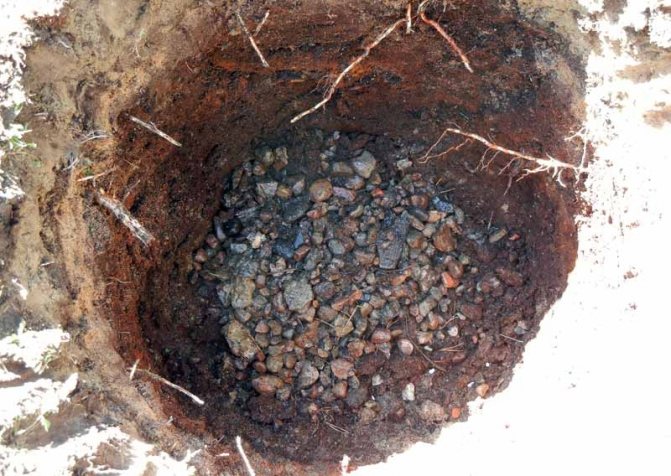

At the bottom of the planting pit for variegated turf, a drainage layer is desirable
Rotted compost or humus must be introduced - about 10 kg per pit. It must be mixed with the top layer (10-15 cm) of fertile soil extracted from it. With gratitude, the variegated dogwood will also accept mineral fertilizing - 50–70 g of simple superphosphate, 25–30 g of potassium sulfate and 40–50 g of carbamide are enough. Those who prefer to do without chemicals can replace them with sifted wood ash. A liter can is enough.
Humus is a natural remedy for increasing soil fertility
The finished planting pit is covered with any material that does not allow water to pass through so that the nutrient mixture at the bottom does not wash out. For example, a piece of slate, roofing material is suitable.
If you plan to plant several single specimens, the minimum distance between the planting pits is 1.7–2 m. When forming a hedge, the interval between adjacent bushes is reduced by 2–2.5 times.
If it is planned to form a hedge from the turf bushes, the distance between them is reduced
For planting, plants up to four years old are chosen. Adult specimens take root much worse. They are purchased (however, like any seedlings) only from reliable, trustworthy suppliers with a good reputation. Shopping at markets, fairs, just off hand is a big risk. A gardener, especially an inexperienced one, can sell anything under the guise of the desired culture. It is desirable that the nursery where the seedlings are grown is located in the same area or nearby. Plants from it are already familiar with the peculiarities of the local climate, this contributes to the fastest adaptation to a new place.
When choosing a seedling, be sure to pay attention to the root system. It should be developed, the length of the taproot should be at least 20 cm. Dried and rotten roots are absent in healthy plants. They should be pliable, creamy white or pale green when cut.The bark of such specimens is smooth, elastic, monochromatic, without spots that suspiciously resemble mold or rot.
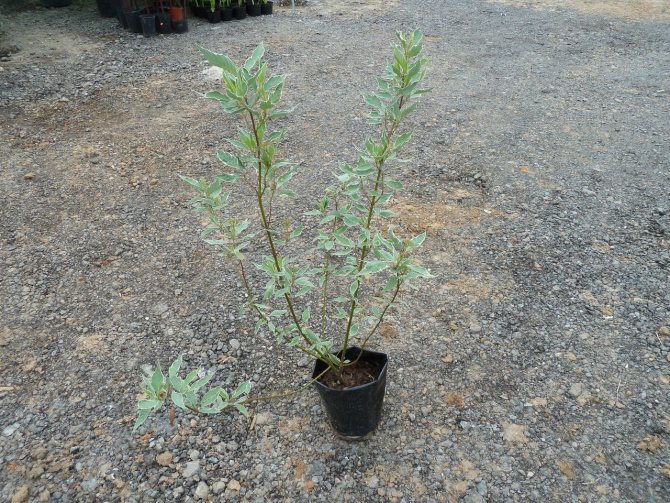

The choice of planting material must be approached with all responsibility.
There is nothing complicated in planting a plant in the ground itself. Even a novice gardener can handle this. It differs little from a similar procedure for other fruit trees and berry bushes.
- In seedlings with an open root system, the roots are soaked for 2-3 hours in water at room temperature. Potted specimens should be watered abundantly about half an hour before planting. In the first case, a little potassium permanganate is added to the water (for the prevention of fungal diseases) and / or any biostimulant (to strengthen the immune system and enhance growth). Then the roots are coated with gruel from powdered clay diluted with water and fresh cow dung. In consistency, this mass should resemble thick sour cream. She is allowed to dry out in the open air. A couple of hours is enough.
- The nutrient mixture at the bottom of the pit is moderately watered and loosened, and a kind of mound is formed from it. If a single planting is planned, for the first time you will need a support - a peg 25-30 cm higher than the seedling, taking into account the depth of the pit. It is stuck into the soil at the bottom, slightly stepping back from the center of the mound.
- The seedling is placed at the bottom of the hole so that its roots are directed downward, and not stick out upward and to the sides. Then it is covered with small portions of soil, periodically slightly shaking the plant to fill the resulting "air pockets". The position of the seedling should be such that when the hole is completely filled up, the root collar is 2-3 cm above the ground surface. If you deepen it, the plant will die. And when it is too high, instead of healthy lateral shoots, weak "offspring" are formed.
- After planting, the soil in the trunk circle is well moistened, consuming 20–25 liters of water warmed to room temperature. When the moisture is absorbed, it is gently shallowly loosened and mulched.
A newly planted bush of variegated turf needs regular watering
Video about planting and further work with the culture
Young specimens of variegated turf tolerate adaptation to new habitats and the associated stress is quite easy. But for adult plants, the process is rather difficult. A transplant is carried out only when it cannot be dispensed with. For example, if a place for a bush is chosen extremely unsuccessfully, it oppresses other plantings, the leaves have lost the variegated color inherent in the variety. In addition, it is difficult to extract an adult plant from the ground due to the developed root system.
The procedure is carried out in late autumn, when the dogwood has completely shed its foliage, or in early spring, when the growth buds have not yet "woken up" and have not swollen. The plant is removed from the ground along with a clod of earth on the roots, trying to damage it as little as possible. The diameter of the root system approximately coincides with the crown of the bush. The earthen lump must be carefully wrapped in plastic or burlap, transferred to a new place. After transplanting dogwoods, they must be watered abundantly, the soil is mulched with humus mixed with peat chips.
Instead of purchasing planting material, you can get it yourself if there are already specimens of variegated turf on the site. The plant reproduces well both vegetatively (cuttings, dividing the bush, rooting of cuttings) and generative (germinating seeds) in a way. The latter breeding method is the most time consuming and time consuming. In addition, it is impossible to guarantee that the main varietal trait will remain - the variegated color of the leaves.
Pest control
Fortunately, the taste of variegated turf does not seem attractive to most pests, so only leafworm and aphids can affect it. These parasites are capable of destroying the entire shrub in a short time.Most often, for the destruction of insects, the "Decis" agent is used, which is used for external spraying of plants. Also, gardeners note the effectiveness of using a solution of grated laundry soap for these purposes (72%), for its preparation you will need 1 piece (based on 10 liters of liquid). A spray bottle is used as a sprayer.
All-season
White and red turf is beautiful not only during flowering and in summer. He also paints the space with bright colors in autumn and especially in winter, when the bright red trunks of red deer light up against the background of the white bedspread.
The shoots of the red turf are a special period, because they are brightly colored branches in green, crimson and yellow tones, and the combination of several types of deren in a certain sequence creates an amazing colored 3D carpet.
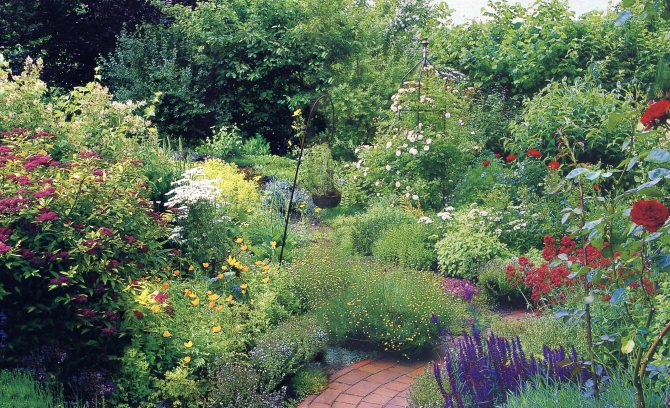

Diseases and pests
Derain cornus is resistant to diseases, but occasionally it can be affected by rot or fungal pathologies. If signs of these diseases appear, you should stop watering, remove diseased shoots and disinfect the soil. With severe lesions, the bush will have to be dug up and burned.
Of the pests, aphids are the most active. With minor attacks, you can get rid of it with a solution of laundry soap. If large colonies are found, special chemicals cannot be dispensed with.
Top dressing
It is enough to apply fertilizers for an adult specimen 1 time for organic matter and mineral compositions. The latter are applied in the amount of 100-150g per 1 bush in the spring. In summer, it is better to give preference to compost, which is embedded in the trunk circle in an amount of about 6 kg each. Mineral complexes are suitable for any with universal recommendations for use.
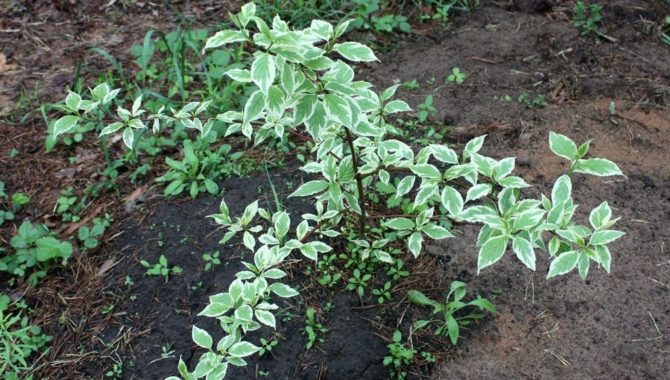

Growing
The shrub is extremely undemanding:
- grows on most of the common garden soil;
- resistant to urban air pollution;
- resistant to low temperatures;
- tolerates pruning well.
Usually the shrub grows well in the sun and in partial shade, varieties with colorful leaves grow better in sunny places.
Watering
Sod care is not difficult, the shrub tolerates short-term droughts, prefers moist soil, a long period without watering can negatively affect the appearance of the plants. In dry and hot summers, the grass is additionally well watered.
Pruning
Anti-aging pruning is recommended for a dense shrub. The shrub withstands pruning well. From early spring to mid-summer, when new shoots develop, 1/3 of the shoots forming the skeleton must be removed, leaving a 5 mm stem of shoots on which new shoots will develop. Pruning is carried out in the spring of each year, shortening the shoots by 1/3 or 2/3 of the length. Thanks to pruning, the bush is modified:
- thickens well;
- releases many new shoots;
- the color becomes expressive, intense.
The bushes need to be heavily pruned immediately after planting (shortening the shoots above 2-3 eyes), so that they open up beautifully from the very beginning of cultivation.
Planting and breeding
Breeding turf is almost as easy as growing. There are 2 ways to breed:
- Saplings. Plants are often obtained by planting green and semi-lignified seedlings (in August, September) and lignified (spring) or cuttings.
- Seeds... Rarely, sod is propagated by sowing seeds. For good germination of seed material, certain procedures and almost 6 months of stratification are required.
Purchased seedlings can be planted in the ground throughout the season, although the best periods are spring and autumn. Most trees grow large, so choose a planting site carefully before purchasing. Saplings are planted rather shallowly, covering the root with a thin layer of soil so that the roots receive oxygen.
Reproduction using cuttings consists in cutting off cuttings from the tops of shoots 8-12 cm long.Cuttings are cut in July-August. The seedlings are soaked with a rooting accelerator (IBA) and planted in a 1: 1 mixture of sand and peat. When breeding deren with cuttings, the temperature is maintained at 15-18 ° C. After rooting the cuttings, the seedlings are transplanted into pots with a diameter of 7 cm, left to winter in a cool room (10-12 ° C). In the spring, the plants are transplanted to a permanent place.
If we want to breed the sod by dripping (layering), we need to carefully bend the young shoots to the ground, bury them in grooves to a depth of 10 cm, removing the leaves. We compact the soil, water it. Lateral shoots are cut at a distance of 2 cm from the root. Weak shoots growing from the base of the mother plant are completely removed.
The layering area must remain moist at all times. At the end of autumn, the rooted plants are carefully dug up, cut into seedlings and planted. This method of reproduction is based on the rooting of shoots, without separation from the mother plant. This is a fairly simple and natural form of breeding that is used by beginners and inexperienced gardening enthusiasts.
Diseases and pests
The shrub is not particularly susceptible to diseases, pests, but in especially unfavorable conditions it is susceptible to the threat of fungal diseases:
- anthracnose,
- dying off of shoots,
- powdery mildew.
Pruning
A turf shrub without stable haircuts will lose its beauty. The shoots will become brown, and their lower part will be completely bare. In addition, without removing shoots and pruning, the plant quickly grows on the sides. Its branches will settle to the ground, roots will fill everything around. Outwardly, the shrub will look very untidy and will cease to be a decoration of the site.
For the first time, it is required to trim the sod when they reach the age of three. In the spring, you will need to cut off all the old shoots by twenty centimeters. In the fall, the procedure involves the removal of all weak shoots that spoil the appearance of the shrub. It will also be necessary to shorten the old ones, which in the spring could be overlooked.
Care
Adult specimens tolerate drought well, but young plants need high-quality watering. Watering should be abundant so that the entire root system is saturated with moisture. Insufficient watering can lead to shrinkage of the shoots. Adult plants should not be watered as abundantly as young plants. An exception is a prolonged drought.
Rolling leaves and drooping branches are a clear sign of a lack of moisture. If this happens, then the culture needs to be watered abundantly, moistening not only the surface of the soil, but also the entire root ball.
In the midday heat, you cannot water the culture. The optimal time is early morning or evening hours.
Spring care includes pruning, top dressing, and occasional watering.
Top dressing is mainly needed only for young specimens. It is recommended to feed with humus or humus. Adult plants need fertilization only after diseases or pruning, as well as if the bush is developing poorly or slowly.
Shelter for the winter is not required, since white turf is a frost-resistant crop. For example, the Elegantissima variety is able to withstand the most severe frosts. Even if the trunk of the bush freezes above the snow cover, then with the arrival of spring, the plant will quickly recover.
Composition with geycher and allium onion.
Briefly about the history of appearance
Weigela shrub - ornamental flowering plant for the garden
The homeland of turf is the northern territories of the globe with a temperate climate. The shrub is especially common in Canada and the northern territories of the United States. Some species only grow in Japan and China. A lot of varieties are found exclusively on the territory of Russia.
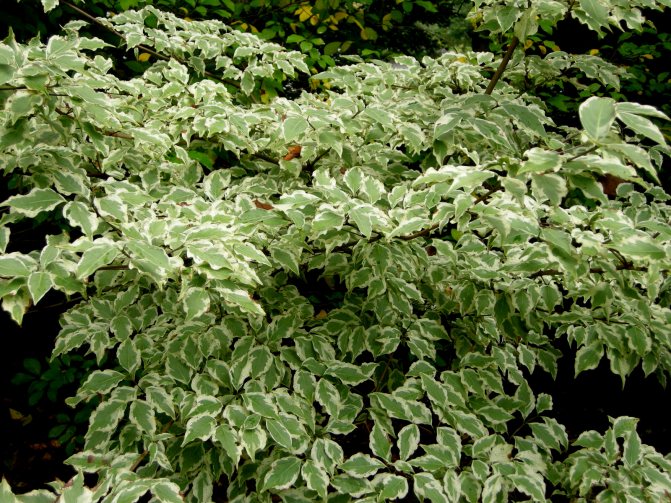

Derain is very much in demand among gardeners.
Flowering and fruiting
Budding usually occurs in the second half of April. The flowers are white, cream or yellow, collected in thyroid or spherical inflorescences.The fruits are edible, despite the fact that in backgammon they are often called "dog berries", they are white or dark blue in color. They are used for the preparation of compotes, preserves and wine, and are also used in folk medicine for the purpose of arresting inflammatory pathologies, improving appetite and digestion in general, and expelling worms. Cornel jam is good for colds.
Potential turf problems
The shrub may develop a fungus. The leaves will begin to turn brown and black, then fall off. Sometimes local brown spots may appear on the stems of the bush. If you do not pay attention to them, the branch will completely dry up and die. This problem occurs due to abundant watering or watering with cold water. The irrigation water should be slightly cool and not hard. The fungus can be cured by treating the dogwood with a solution of Bordeaux liquid or special preparations, such as Vectra or Fundazol.
High humidity and excessive shading of the area provoke the appearance of powdery mildew. It looks like a powdery coating on leaf plates. Soon the leaves turn yellow, curl and finally fall off. They get rid of it with special drugs.
If the leaves dry up sharply and turn yellow to the very central vein, then the bush was burned by the sun. A transplant is needed to a more favorable and shaded place.
Note! Derain has a specific smell that repels pests.
Derain has gained immense popularity in landscape design with its unusual variegated color of leaves. Simple care, along with a beautiful appearance, attracts more and more attention of the turf to its person all over the world.
Step-by-step procedure for planting seedlings
If the terrain is swampy, the planting pit is pre-drained. Compost, peat, sand must be added to it.
If the soil is poor, add 100 g each of superphosphate, dolomite flour and wood ash. The bush is planted with a 3 cm deep root collar.
For a hedge, dig a trench 70 cm deep and 50 cm wide. You can outline the line of the future green fence using a stretched twine.
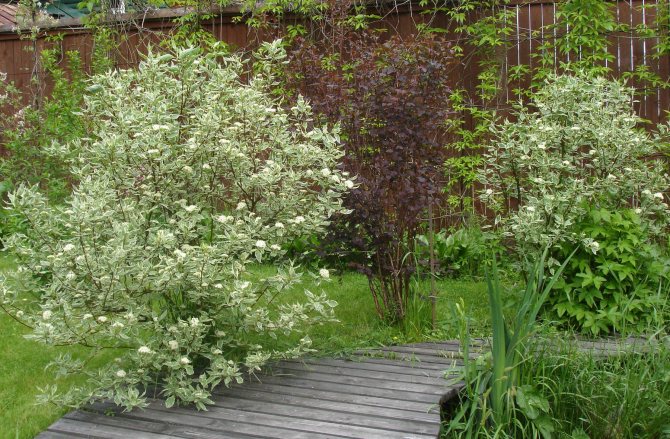

After planting, the earth is tamped tightly, and the bush itself is watered abundantly. Then dogwood is mulched with straw.
How dogwood is propagated
It is possible to plant the grass with seeds - this is a rather lengthy process, so that the bush grows to standard sizes, you will need to wait up to 7-8 years. Therefore, this method is rarely used, although the germination rate of seeds is 100%.
It is better to propagate the shrub vegetatively - it is quick, simple and effective.
Dividing the bush in spring
- An overgrown bush is dug up;
- The root part is freed from the earth;
- A bush is cut with a sharp, clean knife;
- They are planted in prepared pits, sprinkled with humus, watered.
Cuttings
- In the spring, when cutting branches, a stalk with 7-9 good buds is harvested;
- Plant the twigs in a fertile substrate in a greenhouse (either in the ground or under a plastic jar);
- In summer, seedlings are watered, ventilated and fed with fertilizers;
- During this time, roots will appear, in the fall you can plant new trees in a permanent place.
Layers
The spreading crown of the variegated turf makes it easy to get layering from the mother bush.
- A flowing, flexible shoot is taken and bends over;
- You can pin it to the ground with a metal bracket or steel wire;
- Sprinkle with humus, water;
- Spring manipulation will allow the branch to take root by autumn;
- Cut off this stem before wintering and transplant it to a prepared place next spring.
Turf transplant
Turf transplant with healthy growth and proper care is not required and depends only on personal preference and extreme necessity. It is recommended to transplant the bush in the spring, before the swelling of the buds begins. The bush is dug out together with the ground at the roots and transplanted into a hole dug in advance for transplanting. It is better to introduce humus or rotted foliage into the pit before planting.After planting, the grass is watered abundantly with slightly cool rainwater.
Important! The bush is dug out carefully so as not to damage the root system.
Application in medicine
All parts of the deren have medicinal properties. Tinctures and decoctions are made from berries, bark and young roots. They act as antiviral, antipyretic, diuretic, anti-inflammatory agent.
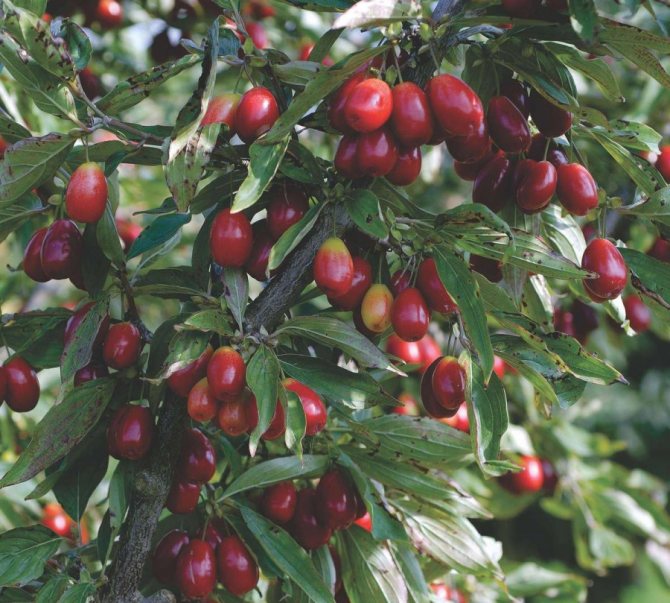

The fruits are very useful, they tone and strengthen the body as a whole. Root tincture helps against a large number of diseases.
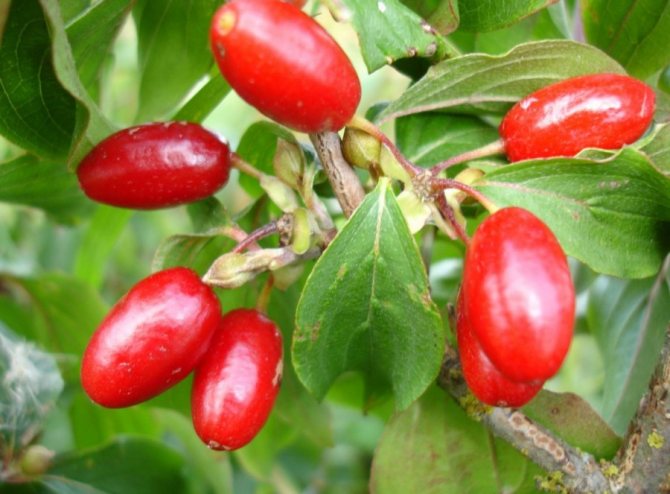

Deren's popularity among gardeners
If we generalize the types of deren, their characteristics and features, then it is worth highlighting the advantages due to which this plant is so common:
- low cost of seedlings;
- high survival rate;
- trouble-free growth;
- showiness;
- a large selection of varieties.
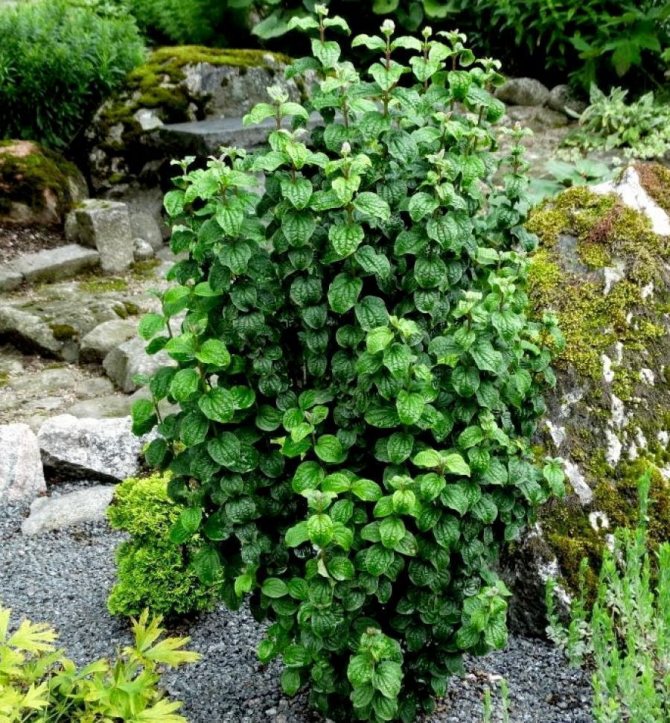

What do breeders write about this plant?
The dogwood family consists of about 50 species, which are generalized and subdivided into 4 subspecies:
- Swida (white or white svidina) consists of 20-30 varieties, characteristic form: small tree or bush with flowers without bracts;
- Cornus - common dogwood, consists of 4 species;
- Chamaepericlymenum or Canadian derain - in total it includes 2 species of plants with a characteristic form of a creeping dwarf shrub;
- Benthamidia - 5 species of trees with variegated colors and original flowers.
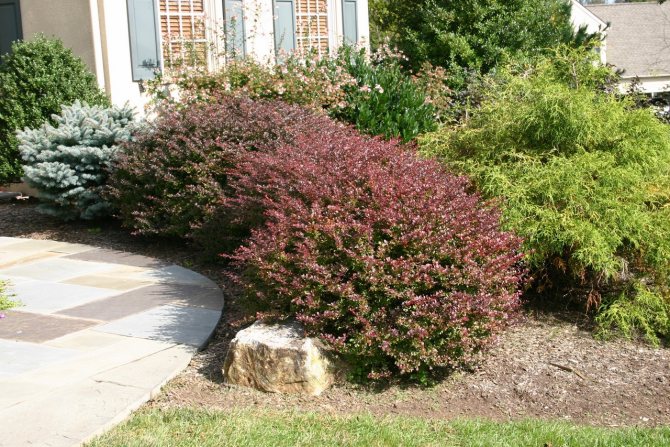

How to trim properly
Among landscape designers, variegated dogwood is one of their favorite crops - it can become the central object of the site, fit into any park ensemble.
This extraordinary shrub can be cut into many different shapes. The laborious pruning process takes place twice a year - in the spring and late summer. First, it is necessary to remove old lifeless branches, as well as excess growth by cutting. The stems sticking out in an unnecessary direction are also removed.


The shrub easily tolerates cutting, new stems grow at an enviable speed in the place of remote shoots.
For arranging arches, decorating gates, creating even landings at fences, trimming is achieved to obtain columns, arcs, spheres and hemispheres, as well as all kinds of geometric shapes.
In order to avoid overgrowing to other areas of the estate, forming pruning is done necessarily and regularly. Giving a beautiful, original shape to the lawn will make the site look unique.
Derain's photo
Selection and purchase of seedlings
Young seedlings take root best of all and give numerous shoots. Their age limit is 4 years. When examined, the bark should not have any mechanical or pathological damage. The root system is strong and not dry, it should have at least 2 branches (preferably 3) 25-30 cm long. If the roots are in order, the height of the seedling itself does not matter.
It is best to buy deren saplings early in the spring, and the seeds in the fall, in order to have time to stratify them.

